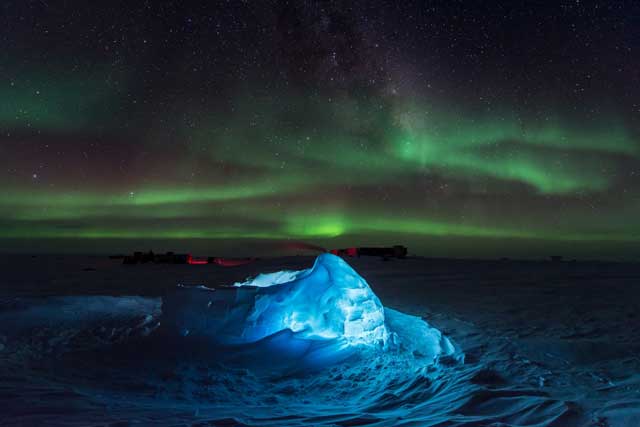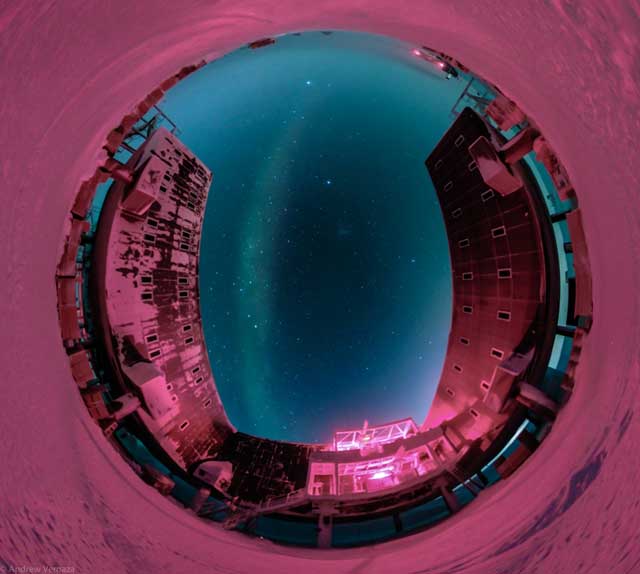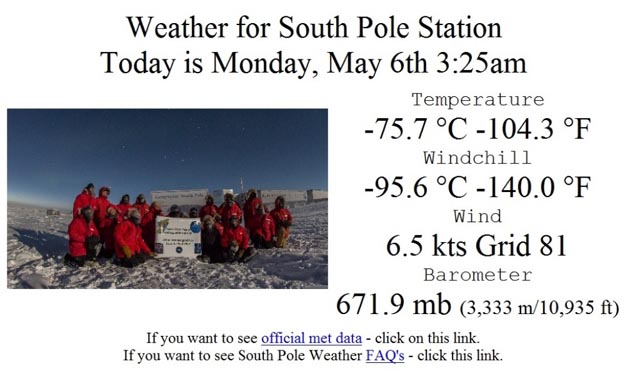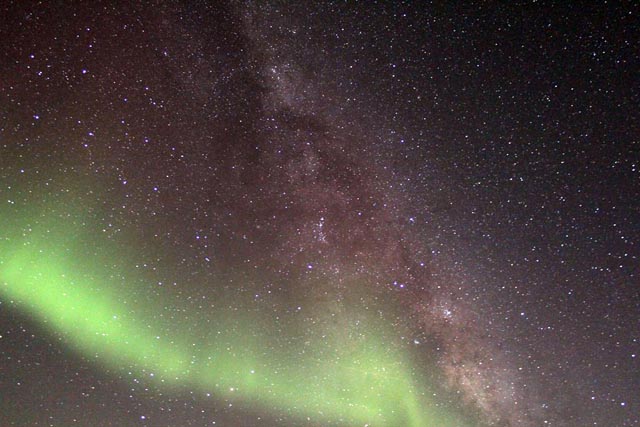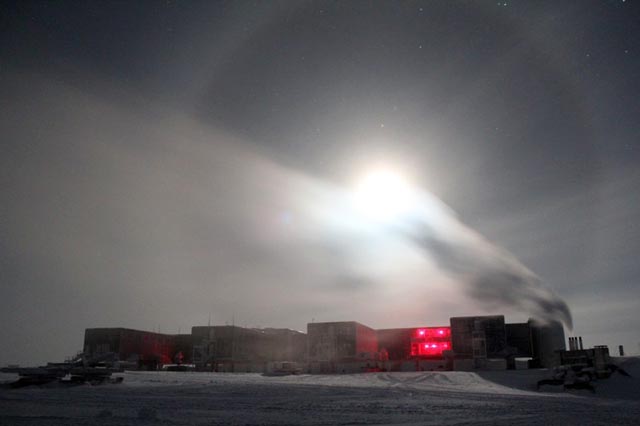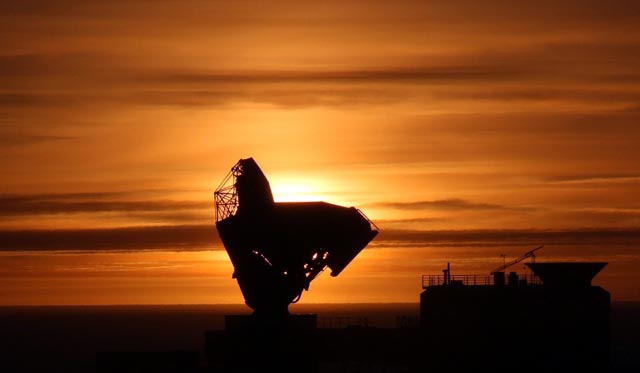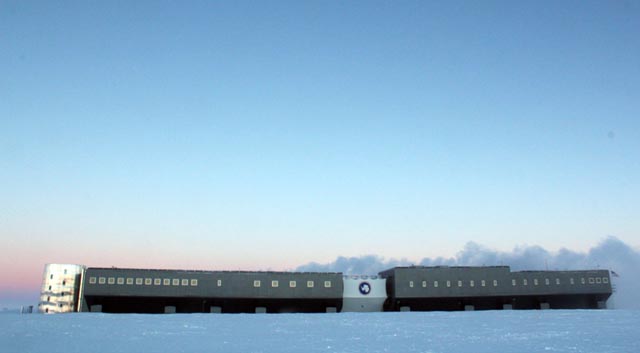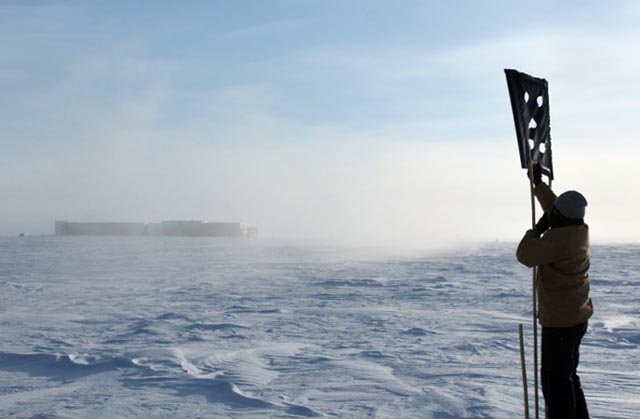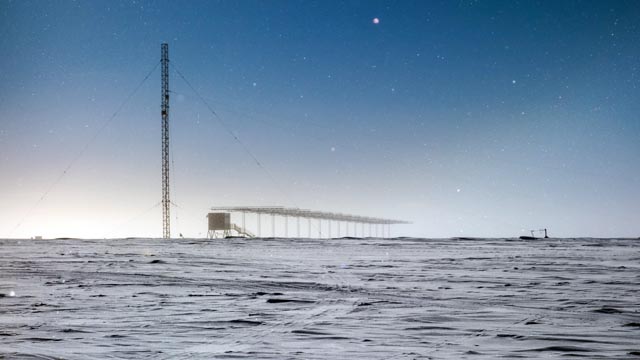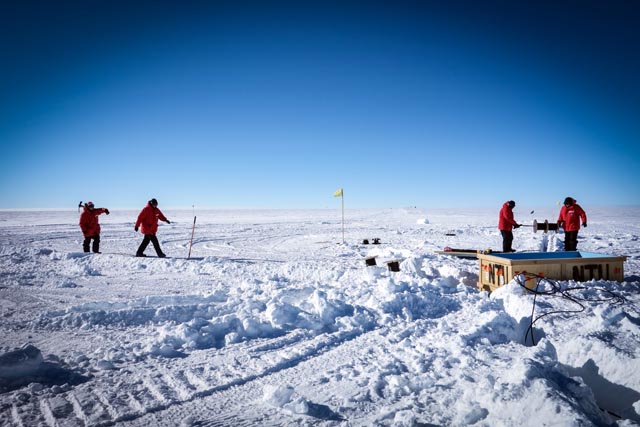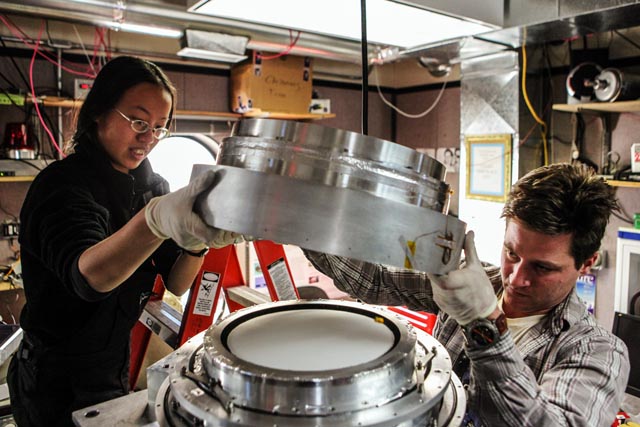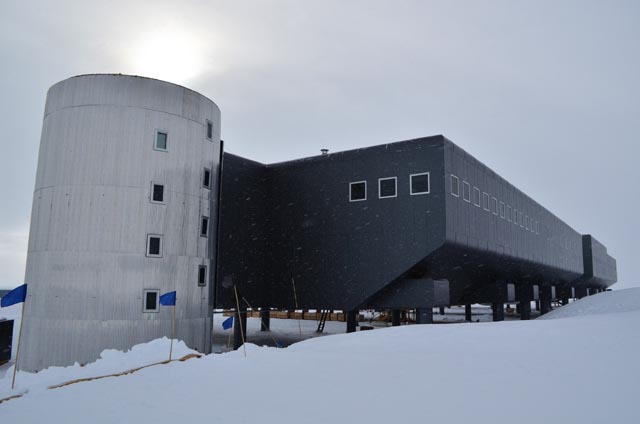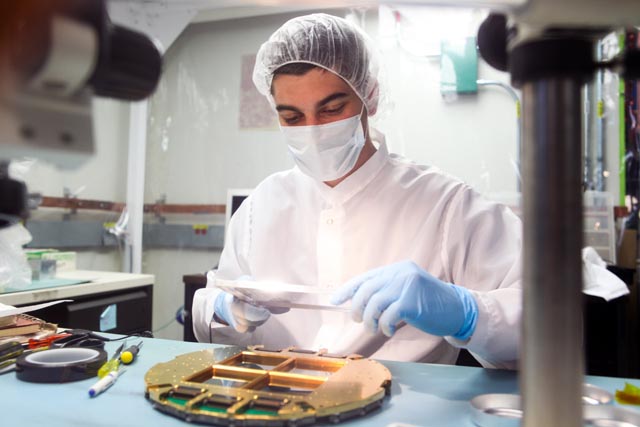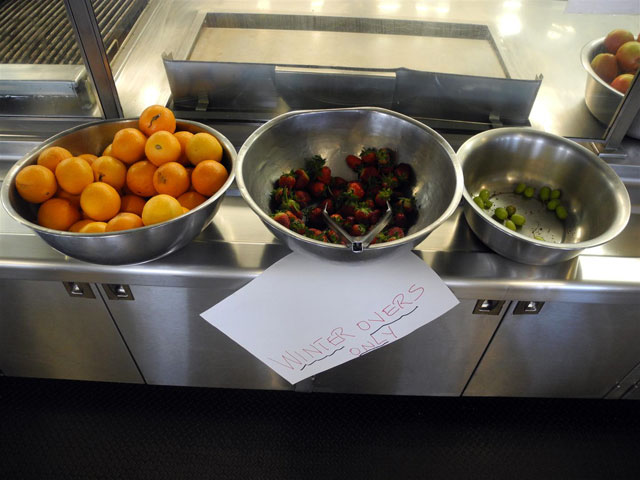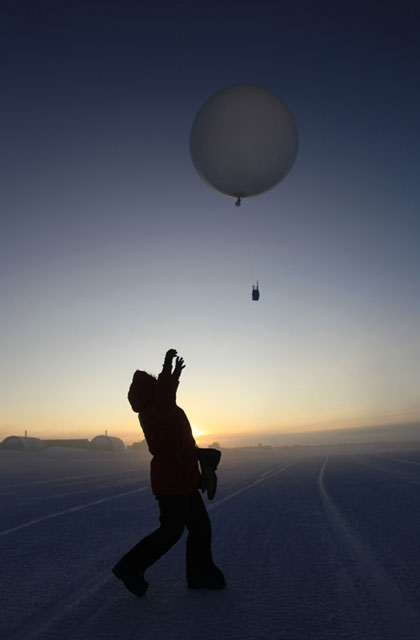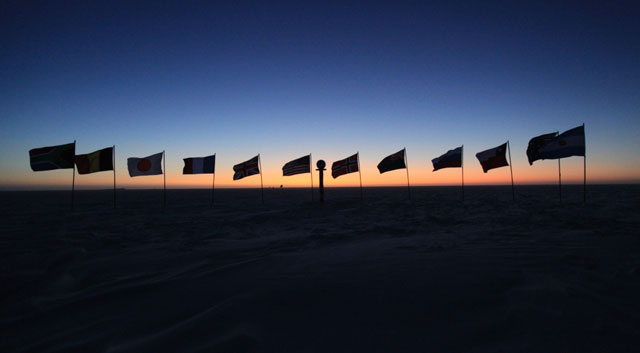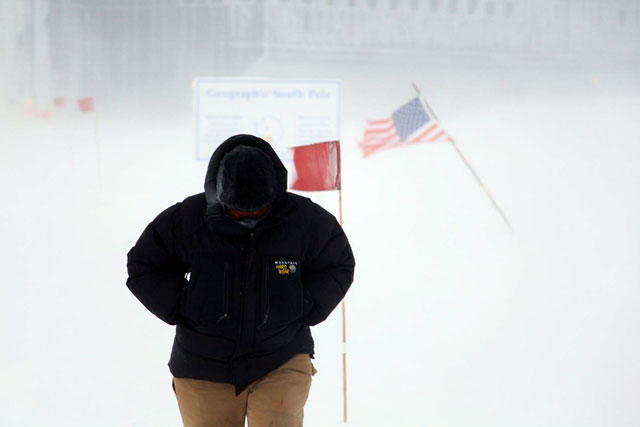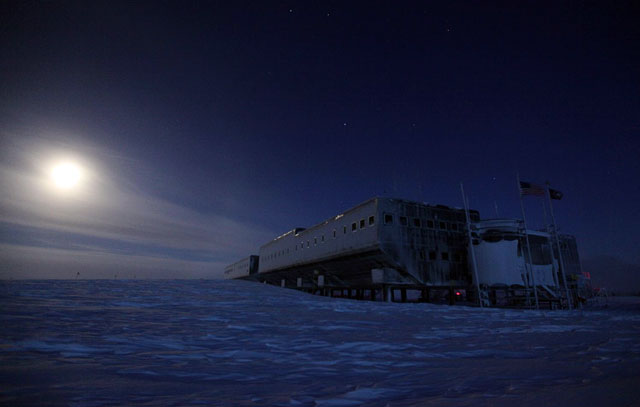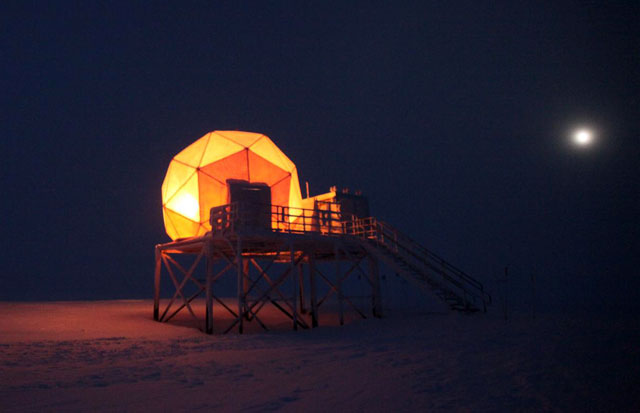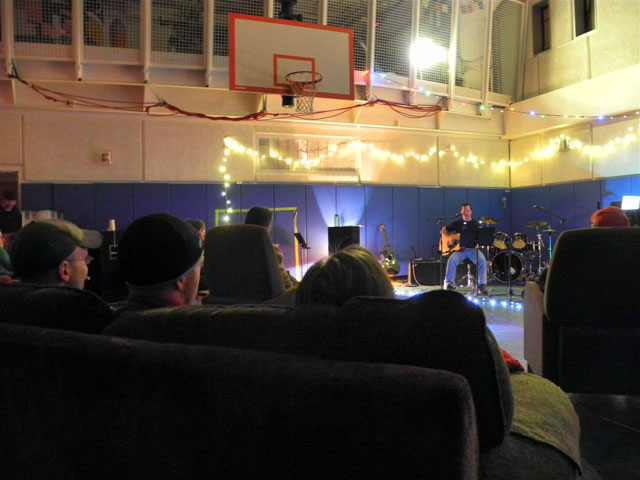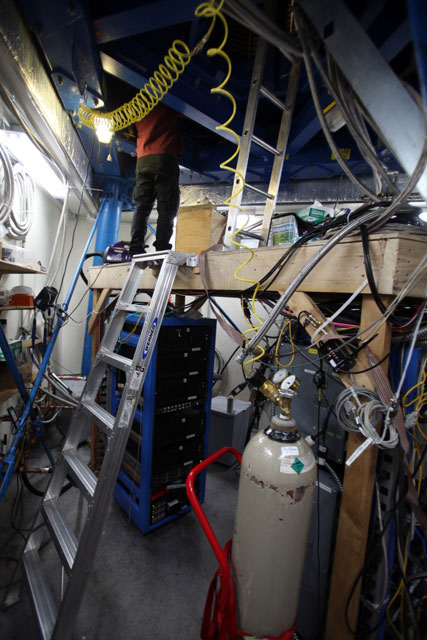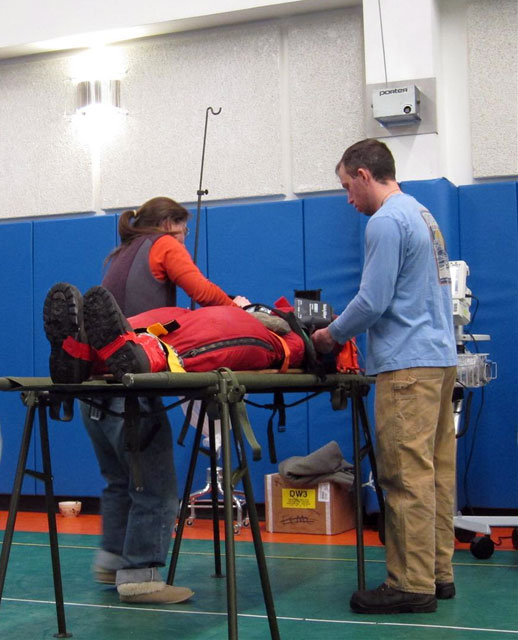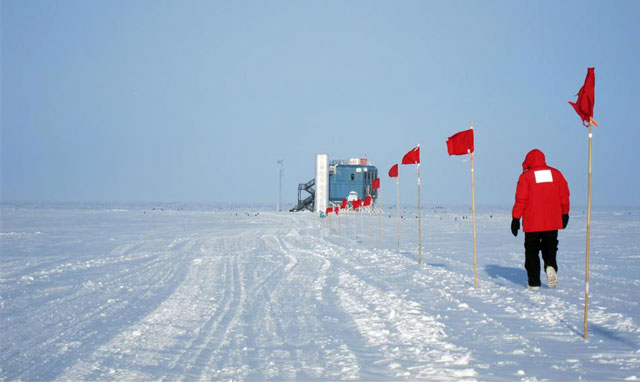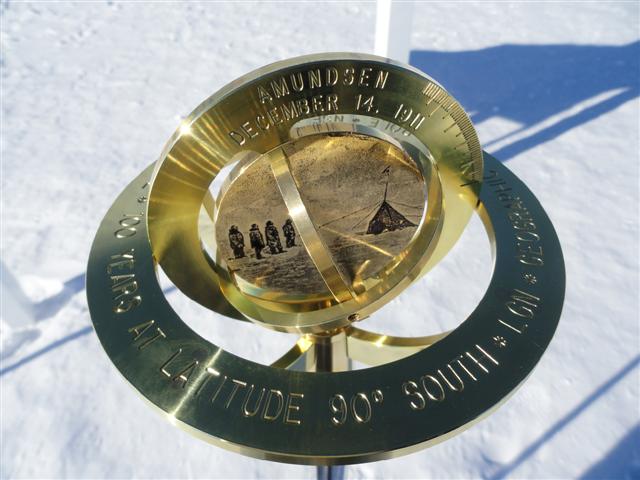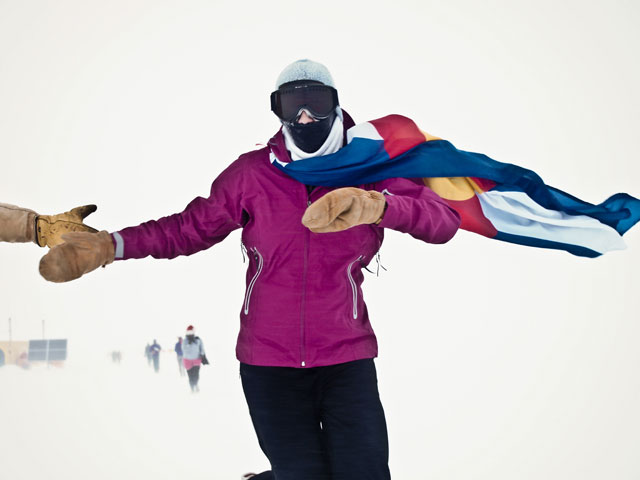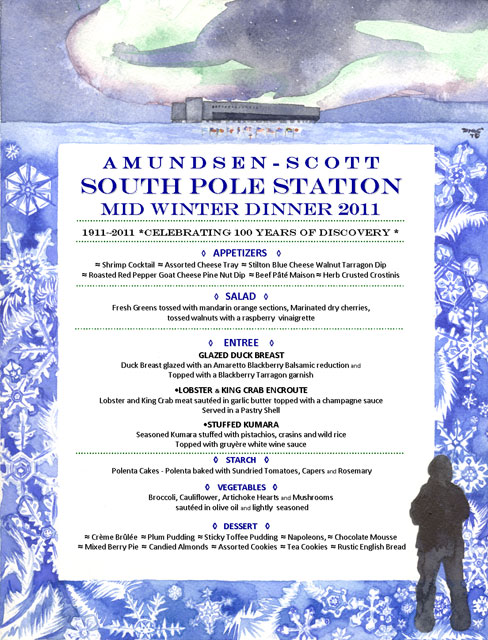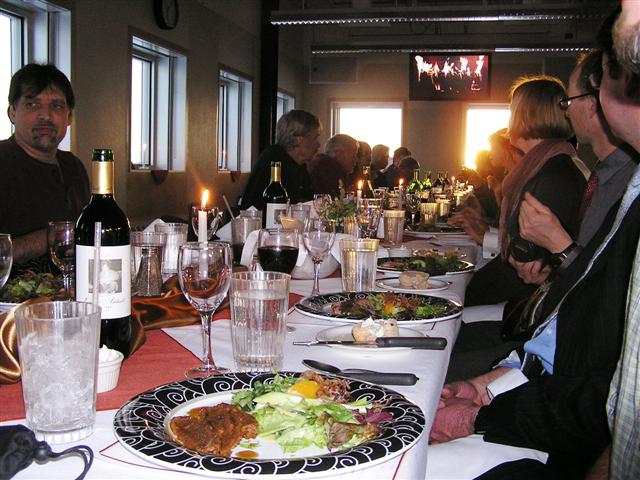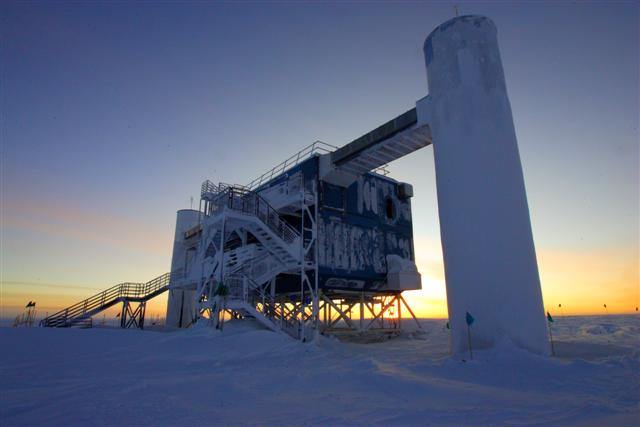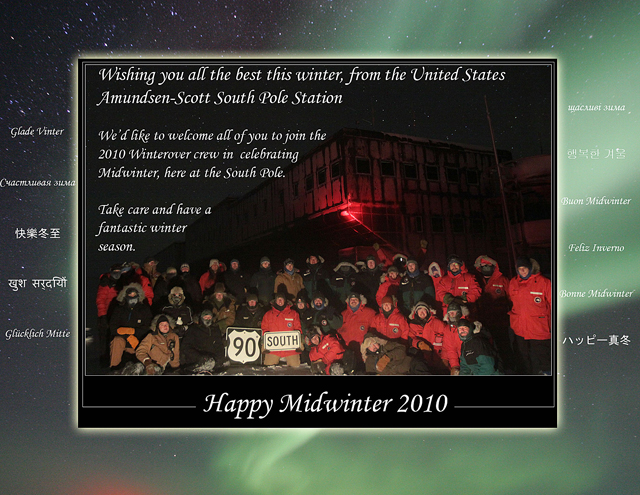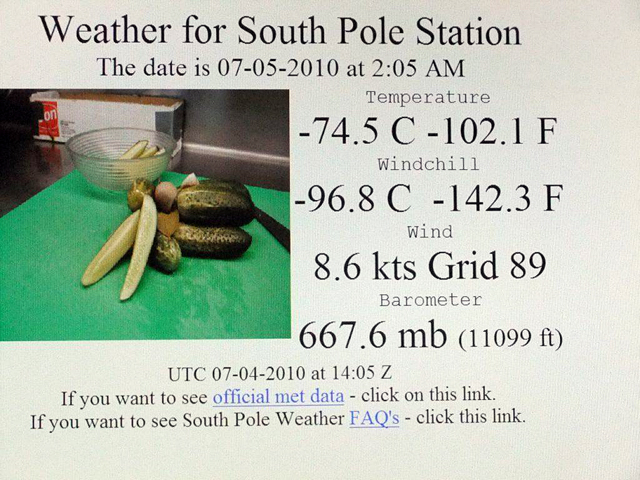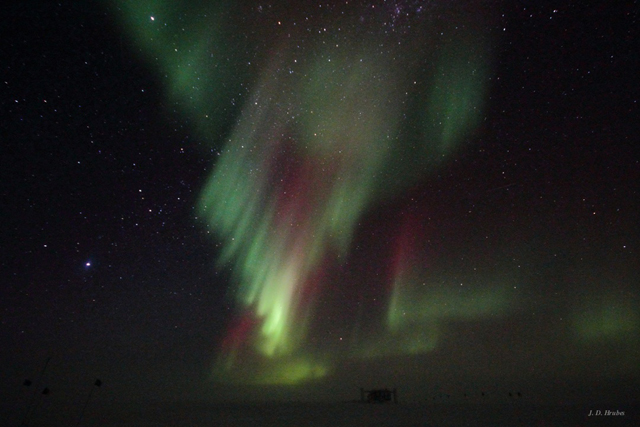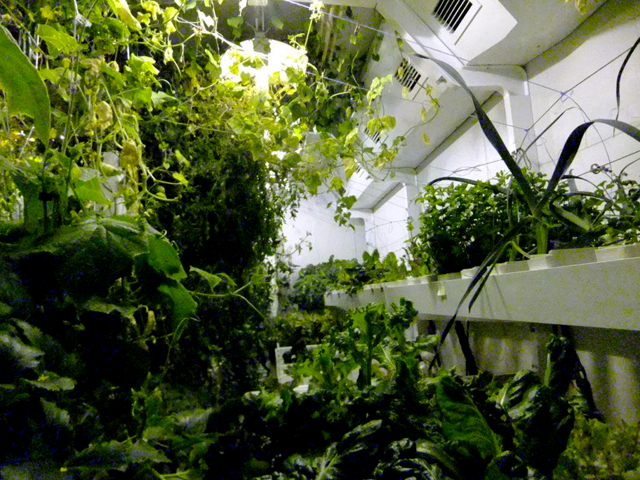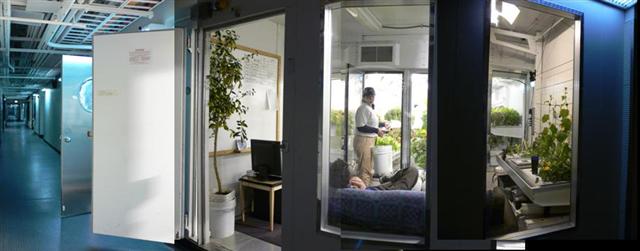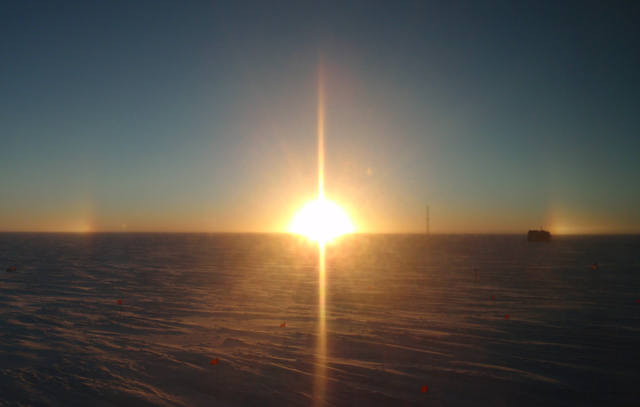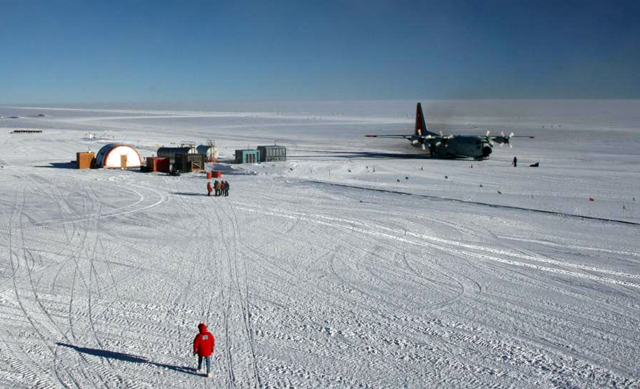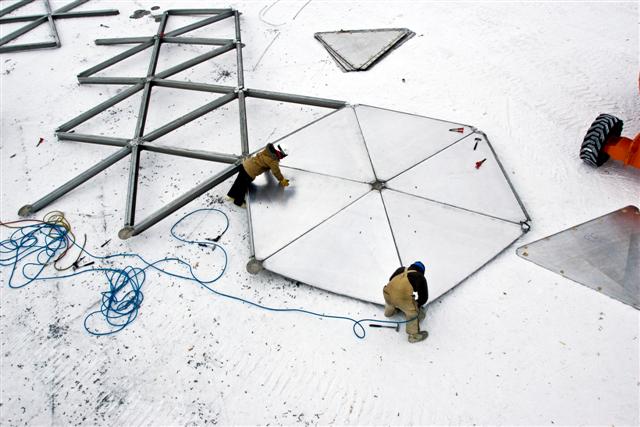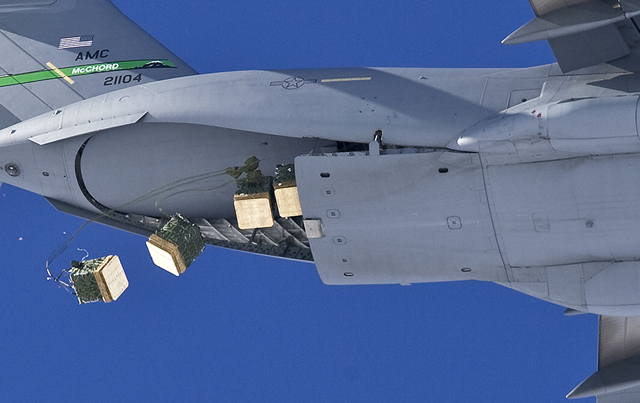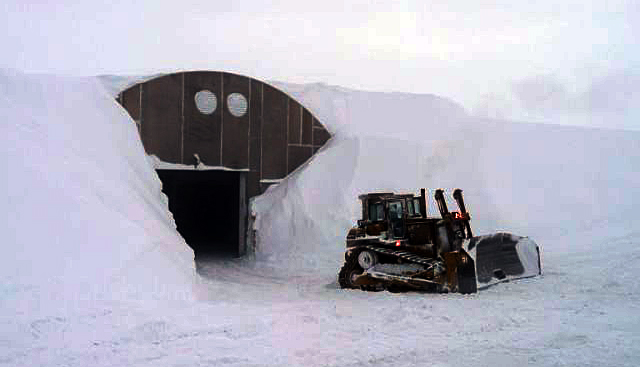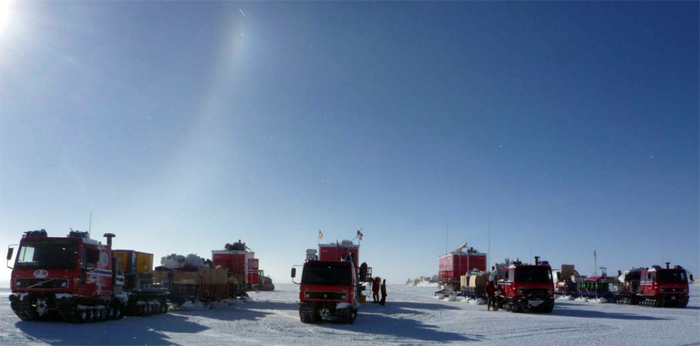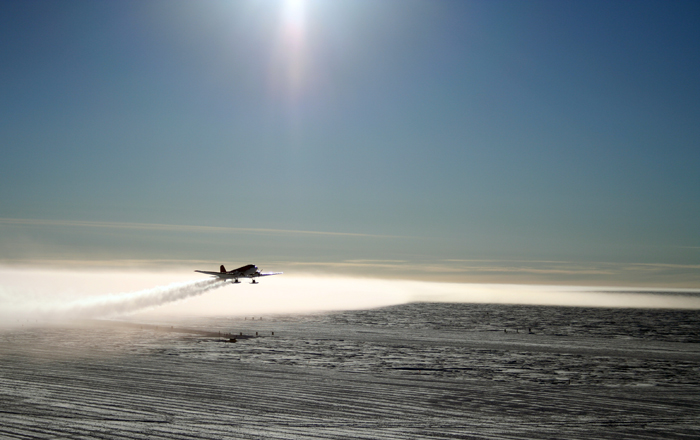|
South Pole Station Archives
Dark and stormy August gives way to the rising sunPosted September 6, 2013
August is finally over, and the horizon is bright with the promise of the sun’s return. It’s been a stormy month, and the snowdrifts around the South Pole Station Rough redeployment dates for the crew have been issued, and folks are busy planning adventures for after the season. Meanwhile, we continue to find ways to recreate on the Ice: Soccer, badminton, and the pool tournament are still going strong. This past weekend, a group got together and transformed the dining hall into a 1950s style burger bar, complete with wait staff. Afterward, we had a showing of the Antarctic Winter International Film Festival submissions. It was a good change of pace and interesting to see some of the other stations’ entries. The IceCube Neutrino Observatory The weather here at Pole has been all over the board; the first half of the month was stormy and dark. On Aug. 4, we set a new wind speed record for the season, with gusts up to 52 miles per hour (mph). With the cloud cover, temperatures were warm, reaching a high of minus 36.4 Fahrenheit on Aug. 5. It cooled down as it cleared, and during the last week of August we hit minus 97.1F. There were a few good aurora events, though more and more they are being washed out by the rising sun. South Pole enters final stretch of winter seasonPosted August 9, 2013
We have reached the final stretch of true darkness here. The black sky above shimmers with a plethora of brilliant stars, as auroras fade in and out. The moon will rise in two weeks, bathing us in its silver light, and by the time it sets again in late August, the first hint of the sun should be visible on the horizon. This past month has gone by quickly. People have hunkered down, waiting for the sun, a plane, or both. We celebrated Christmas in July with a painted and decorated cardboard Christmas tree, a showing of Elf and National Lampoon’s Christmas Vacation, a white elephant gift exchange, and a big Christmas dinner. Weeknights have been busy with soccer and badminton games, and the pool tournament is in full swing with games on Tuesday and Thursday evenings. The research projects here have been operating smoothly with minimal issues — and some maximum results. The South Pole Telescope The find suggests that scientists are close to finding B-modes created by gravity waves, which would have been generated during the rapid Inflation of the universe. Detection of B-mode gravity waves would prop up the theory of Inflation and further support the standard model of cosmology. Link to news: http://news.sciencemag.org/space/2013/07/swirls-afterglow-big-bang-could-set-stage-major-discovery. The IceCube Neutrino Observatory South Pole weather was steady last month, with temperatures ranging from minus 34.4 degrees Fahrenheit to minus 98.3F. We’ve also had quite a few good aurora events! South Pole redefines the idea of cold temperaturesPosted July 19, 2013
We are in the very heart of the long Antarctic winter now, with a little more than four months since the last plane left and roughly four months yet to go until the next flight. Our bright star has finally reached its lowest point (23.5 degrees below the horizon) and will now begin the slow trek back toward us – rising on the September equinox. Midwinter here at the South Pole Station On Friday, June 21, we had the opportunity to speak with some of the first winterovers ever — Polies from the 1957 season who had assembled for their biennial reunion in New Orleans. It was fascinating to hear some of their stories about having dogs on station and what it was like to winter with only a handful of people. They only had high-frequency radio with which to contact the outside world. The recreation schedule has been full, with soccer, badminton, Game of Thrones, and Monday night science lectures/travelogues. The Pool Tournament has begun, and an Open Mic night was a lot of fun. More than half the station showed up to watch a few performances and listen to some great live music. Weather-wise, June has been a month of extremes. We had several back-to-back storms, and on June 22, broke the June wind speed record of 46 mph with gusts up to 51 mph. We also set a new low temperature for the season so far at minus 107.9F on June 8. About a week or so later, on June 19, we reached minus 19.8F, setting the all-time record high for the month June. Despite the warm fronts, we’ve passed the minus 100F threshold five times now. These extreme cold temperatures define a whole new meaning of the word “cold.” Physical properties change. This degree of cold makes metal tracks on the equipment pop and crack, sounding like Rice Crispies. It freezes Sharpie markers after a minute or two, leaving only a streak of black felt scraped off the tip. Filmy plastic bags become so brittle that even being bent by the wind will snap them in half. Elastic bands on headlamps freeze solid, cracking sharply when adjusted or stretched. Rubber seals break in half at the lightest pressure. Metal zippers become cold enough to burn fingers if touched with bare skin. Cameras slow until the shutter freezes in place. Even hard plastic will crack if dropped. My breath freezes in the air so quickly there’s a sound to it — a gentle exhale, silent in warmer temps, produces a rushing sound, as if I were blowing out forcefully. The snow is like Styrofoam; the air perfectly clear. Sound travels amazingly well; footsteps echo and voices carry easily a quarter mile. It’s a cold sharpened by the wind, and with a wind chill of minus 150F, it’s cold enough to cause frostbite after only a few minutes. Bundled up, however, it’s tolerable for an hour or two. The most important part is keeping the mouth covered, as air this cold will burn lungs, resulting in a cough that lasts for several days. Life may have been different at South Pole in 1957 — but the extreme temperatures here will never change. Mercury plunges below minus 100F twice in MayPosted June 7, 2013
Life and science perseveres here at the southernmost station. We are in the heart of winter now, and with the sun at 21 degrees below the horizon, there’s not so much as a hint of light anymore. The moon rises and sets roughly every two weeks. When it’s below the horizon, we are plunged into complete blackness. Then, rising close to full, it brightly illuminates the South Pole Station The month of May has been cold; in fact, the coldest yet this season. On May 5, we finally hit the magic threshold of 100 degrees Fahrenheit below zero! The temperature continued to drop throughout the night, reaching a low of minus 104.3F at 3:25am on May 6. We hit minus 100F again on May 22. At those temperatures physical properties of materials begin to change. The flaps on cardboard triwalls snap clean off before bending; metal becomes brittle; plastic disintegrates; leather and elastic bands shatter; and even our cold-designed AN8 fuel begins to gel. With these cold temperatures the, heaters in some of the outbuildings have been acting up, keeping our facilities engineer and the utilities technicians very busy. While the South Pole Telescope Some exciting events of this past month include the appearance of a rare phenomenon known as Yukimarimos on May 3. A 1999 Nature article described the first scientific description of these snowballs as “delicate needles of hoar frost [that] form on the surface of the snow. Some of these are rolled about by the wind and create these fragile snowballs, which grow to a size of about 30 mm.” Some of the ones we saw exceeded 90mm. These giant snowballs were incredibly fragile; light as air, yet easily destroyed by a strong gust of wind or simply by the force applied in an attempt to pick them up. They congregated under the station and in the hollows between sastrugi, before eventually being blown out onto the plateau. On May 18 we hosted the newly renamed 8th Annual South Pole Indoor Costumed Event (SPICE) 5K. There was a decent turnout, and costumes ranged from a giant banana to Bob the Builder. The course involved 18 laps around the inside of the elevated station, and prizes were awarded for fastest individual, fastest team, and best costume. 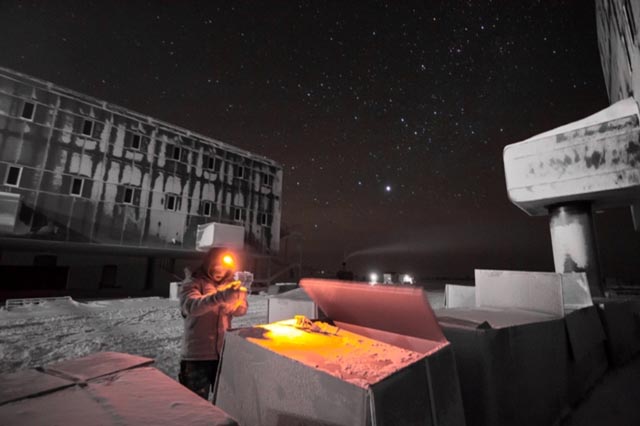
Photo Credit: Felipe Pedreros
Waste management specialist Marie Mclane secures a trash bin outdoors near the station.
This season the greenhouse has been producing lots of kale, chard, lettuce and nasturtiums, as well as a few cucumbers, sugar snap peas and tomatoes. We even had the first Sun Jewel melons and jalapeños of the season, which were sliced up for all to enjoy and celebrated with a small “Farmers Market” gathering. Auroras have become almost a common occurrence, though a good show stills draws a crowd out of the warm station, with photographers armed with tripods and Big Red parkas. Grantee Robert Schwarz All in all, things are well here at the South Pole, with midwinter fast approaching. Extreme temperatures and night sky highlights in April at PolePosted May 10, 2013
The sun has fully set, the moon has risen, and it’s open season on Aurora Australis. South Pole Station The month of April kicked off with the lowest temperature we’ve seen yet this season: minus 98.9 degrees Fahrenheit. Just a week later, it was back up to the month’s high of minus 40.9F on April 9. A series of wind storms came through mid-month, with gusts up to 40 miles per hour. The subsequent drifting and sastrugi are just enough to derail the casual pedestrian craning their neck for a look at the stars and dancing auroras. With temperatures the last few weeks between minus 75F and minus 85F, it’s been too cold to operate much equipment. It’s definitely cold, a whole new meaning of the word for those who are new to the Ice. The soft leather on my camera strap shattered, and extension cords can be cracked in half. Thankfully, our extreme cold weather (ECW) gear has served us well, and everyone’s been fairly well prepared. One would hope, at least, that agreeing to winter at the South Pole would come with the expectation it to be cold. Science here at the South Pole is chugging along smoothly. The IceCube Observatory According to Thomas Gaisser International Yuri’s Night was celebrated on April 12 in honor of Yuri Gagarin, the first man in space. It was complete with space-related — and plain crazy — costumes. On April 25, a more somber event was hosted by our resident Australian for ANZAC (Australia and New Zealand Army Corps) Day, with freshly baked ANZAC biscuits and a showing of Gallipoli. Other social events this past month included bingo, kickball, a movie marathon, and the premier showing of Thin Ice Sun sets at the South Pole with a couple winter-over recordsPosted April 12, 2013
After the longest day — six months of continuous daylight — the sun has finally set and has cast the South Pole Station The official equinox was two minutes after midnight on Thursday, March 21, though we saw beautiful sunset colors through Monday, March 25, before the clouds rolled in. This is a special time of year, and the last time we will see the sun until the southern vernal equinox in September. We celebrated the occasion with a special dinner on Saturday, March 23. A telescope in the station dining hall, or galley, provided some great views and allowed some shots of the green flash. We are now in a period of civil twilight — a couple of stars have popped into view — and it’s getting darker every day. Temperatures dropped in early March, reaching a serious low of minus 91.1 degrees Fahrenheit on March 25. Over the last week of March, however, they’ve risen dramatically to minus 17.3F on March 29, beating the previous maximum temperature record of minus 21.8F set in 2010. The unofficial South Pole winter-over statistics have been completed this year by Bill Spindler, who maintains the southpolestation.com March was full of summer closing activities, as everyone settled into his or her role. The skiway flags are down, and the berms have been flagged. The aircraft fueling module, the cargo yard, and waste yard have been cleaned up and everything either stored on the berms or on sleds pulled out to the “end of the world,” away from the station. Drifting snow during the eight months of winter can be a serious issue. The big bay doors to the various arches that house the garage, power plant and logistics facility have been closed. Window covers will go up next week on the main station building to prevent interference with light-sensitive experiments. The big research projects have all been operating smoothly, with no significant issues. The new Atacama Large Millimeter/submillimeter Array (ALMA) The expedition known as The Coldest Journey South Pole enters winter with crew of 44 peoplePosted March 8, 2013
February was a big month for the South Pole Station The 2012-13 summer field season was successful and productive in the first year of a significantly downsized support population. The peak population fell from about 250 to about 160 this season, as the population aligns with the design of the elevated station, which can house about 150 people. The delayed return of the Air Force C-17 The South Pole entered the winter season a day earlier than planned this year on Feb. 14. It was a dramatic ending to the summer, with one of the final flights boomeranging back to McMurdo due to a mechanical problem. Temperatures on the final day were already dropping precipitously, down to minus 47 degrees Celsius, nearly to the point where the New York Air National Guard’s LC-130 Hercules All the winter-overs came out to send off the last of the summer crew. That first full night of winter, as per tradition, all three versions of The THING (1951, 1982 and 2011) were shown in the gym. Two Twin Otter aircraft remained around station for several days. One plane was working in support of the Italian Antarctic program, and it began the long journey back to Canada through the British Antarctic Survey’s Rothera Station 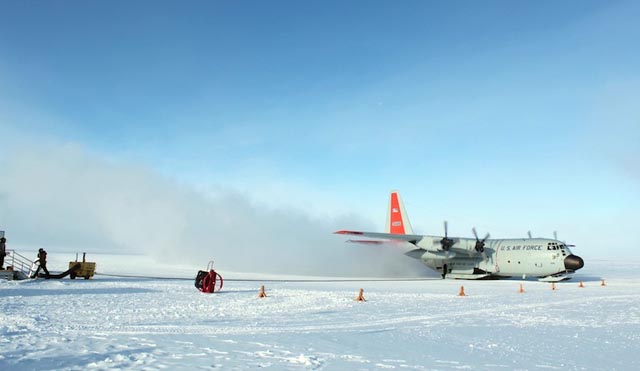
Photo Credit: Marie McLane
The last LC-130 of the 2012-13 summer season leaves a thick contrail in the air due to the extremely cold temperatures.
The other Twin Otter stayed at Pole for another day as a backup for search and rescue operations until a science traverse team returned to McMurdo Station after traveling across the Ross Ice Shelf. Finally, on Monday, Feb. 18, it headed north via Rothera Station, leaving behind 44 souls. The South Pole has been manned year-round since 1957, making this the 56th crew to winter-over. The station has been a hive of activity over the past two weeks, as departments clean up and prepare for the winter. The big projects currently under way mainly involve the airfield — taking down the skiway and approach-way marker flags, rolling up the summer fuel lines and the aircraft fueling module. There are a number of active science projects this winter, both big and small. Some of the larger, long-term endeavors include: IceCube Neutrino Observatory Temperatures since the winter season began have ranged from minus 40C to minus 50C, and while the sun is shining brightly, it’s at about 9 degrees above the horizon, casting long shadows. The sun will set on March 22. New experiments installed at the South Pole in JanuaryPosted February 8, 2013
January is the last full month of the summer field season at the South Pole Station A new experiment was installed last month in the station’s Cryogenics Lab, which is being repurposed because there is no longer a need for liquid helium to the super cool the sensors used for certain telescopes. [See previous article — Full of cold air: South Pole Station makes the most of liquid helium supply.] The installation of the South Pole Lorentz Invariance Test (SPLIT) is being overseen by Princeton University 
Photo Credit: Jeffrey Donenfeld
South Pole research associate Andrew Vernaza, left, and scientist Marc Smiciklas install the SPLIT experiment in the former Cryogenics Lab.
SPLIT aims to detect violations in Lorentz Symmetry by measuring the spin of individual atoms of neon inside its bell-jar-enclosed co-magnetometer. Lorentz Symmetry is the fundamental symmetry of the standard model of particle physics, as well as general relativity, which describes gravity. A violation in this symmetry would suggest that there’s a new element to physics which falls outside of what the current standard model can predict. The SPLIT apparatus arrived in January. One of the main tasks involved alignment of the sensitive laser optics. Smiciklas will work with research associate Andrew Vernaza on developing comprehensive maintenance, testing and operating procedures for the winter. Another new experiment sprung up in January — a new radar was built at the South Pole as part of the Super Dual Auroral Radar Network (SuperDARN) The SuperDARN site installation team, led by principal investigator Bill Bristow Near the end of the month, the SuperDARN team finished verification and testing of the new radar, and is now prepared for a winter of transmitting. Work also continued on a number of other ongoing experiments. Askaryan Radio Array The Askaryan Radio Array (ARA) After the drill team finished drilling the final holes, the ARA deployment team got right to work installing ARA’s sensors deep into the ice. After sensors were deployed, data acquisition boxes were installed near the surface of the ice, and connected to the IceCube Laboratory via buried fiber optic cable. South Pole Telescope January has proven to be a busy and productive month for the South Pole Telescope In particular, the team spent January collecting “point source” data by looking at the planet Venus. These data are used to assess the shape and other characteristics of the telescope’s beam, so that accurate measurements can be made during the winter. So far, the beam has been found to be almost completely Gaussian, or bell-shaped, which is the beam’s ideal shape. The SPT experiment is now looking for signs of inflation, when the universe expanded after the Big Bang, after a five-year project cataloging galaxy clusters in an effort to understand dark energy and other mysteries of the universe. South Pole Remote Earth Science Observatory The South Pole Remote Earth Science Observatory (SPRESO) In addition to monitoring seismic activity in the pursuit of earth sciences, SPRESO “also serves as a United States contribution to the International Monitoring System for the nuclear Comprehensive Test Ban Treaty,” according to the project description on the web site. In January, the SPRESO maintenance team completed calibration and testing of key seismic sensors, removed older equipment from the site, as well as installed a few new sensors. SPUD The Small Polarimeter Upgrade for DASI (SPUD) Scientist Abigail Vieregg said that major upgrades to the sensors took place, including a swap-out of entire focal planes from the five receivers. One of the SPUD receivers was implanted with the refurbished sensor the from now-dismantled BICEP2 In addition to a healthy amount of science progress in January, South Pole also completed a number of station operations and construction projects. In support of the South Pole's continuing sewage disposal and fresh water requirements, the Rodriquez well (Rodwell) #3 was successfully brought online in January. A bulb of water is melted in the ice sheet to provide the station with a fresh water supply. Meanwhile, Rodwell #2 is being converted to contain the station’s sewage outfall. As a result of a bit of differential settling of the ice under the South Pole garage, a routine leveling of the garage support structure took place in January. After inspecting all platform supports, a team led by Josh Miller placed shims underneath the support columns to strategically level the floor that supports the garage structure, walkways and offices. In order to keep proper airflow passing under the elevated station, which prevents the accumulation of snow under the building, the annual snowscaping took place early in January. Snowplow operators carefully shaved down the snow berm that had built up in front of the station, providing a smooth downward slope extending from just in front of the ceremonial South Pole all the way under the building. A grid of marker flags was arranged on the berm to measure snow drift and buildup during the winter months. Tis the season for science upgrades at South PolePosted January 4, 2013
December continues another epic summer season here at the Amundsen-Scott South Pole Station This year at Pole, new experiments are being set up everywhere, and existing experiments are actively being worked on, calibrated and upgraded. 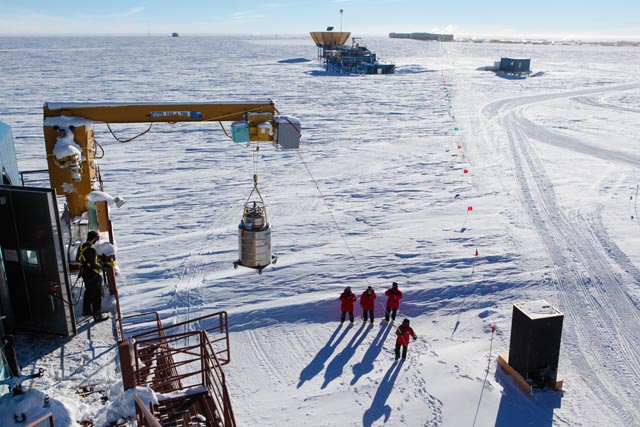
Photo Credit: Jeffrey Donenfeld
The BICEP2 telescope was officially decommisioned and removed from its space at the Dark Sector Lab.
Scientists on the Small Polarimeter Upgrade for DASI (SPUD) In November, the team did a few initial tests on SPUD (also known as the Keck Array), and then warmed up, dismounted and disassembled two of the five sensor-housing cryostats. Once disassembled, the main focal planes were carefully removed by physicist Grant Teply in the Dark Sector Laboratory’s clean room, and then transported back to NASA’s Jet Propulsion Lab Starting in December, the team continued to test and calibrate the assembled cryostats. Additionally, near the end of December, the main focal plane removed from its sister experiment, the BICEP2 telescope Speaking of BICEP2, the CMB telescope, which has been used to investigate the theory of inflation after the Big Bang (like SPUD), was officially decommissioned in December after final calibrations earlier in the season by physicist Jonathan Kaufman. [See previous article — Inflation at South Pole: New telescopes search universe for signs of rapid expansion after the Big Bang.] The end of BICEP2 also means the end of liquid helium at the South Pole. Liquid helium has been used to super-cool the sensors used by some of the experiments during their scans of the CMB. New instruments like SPUD and the South Pole Telescope The final liquid helium fill up for the Cryogenics Laboratory happened in December by cryogenics technician Flint Hamblin. Previously, Hamblin would make intermittent trips on his snowmobile to the Dark Sector Lab (DSL) where BICEP2 was housed to deliver liquid helium, towing a sled with the stainless steel liquid helium dewar strapped to it. [See previous article — Full of cold air: South Pole Station makes the most of liquid helium supply.] It’s been a busy season for a team installing the initial phase of the Askaryan Radio Array (ARA) The ARA team has set up their workshop adjacent to the IceCube In December, the ARA team deployed their drilling rig to the field, and is currently hard at work drilling the first holes of the array. Daily drilling operations continue to go smoothly, as the team overcomes challenges involved with drilling into the soft firn layer of ice. Principal investigator Albrecht Karle Meanwhile, the South Pole’s most famous ongoing neutrino experiment, the IceCube Neutrino Observatory, focused on network upgrades by its two winter-over scientists Blaise Kuo Tiong and Nils Irland. In December, the team completed system monitoring software upgrades, and continues to prepare the lab for upcoming detector operations in January. Research keeps everyone incredibly busy at the station, so we value those moments when we’re allowed to relax a bit. In November, the big moment was Thanksgiving, and by the time it ended, everyone was stuffed. The evening kicked off with an introduction by executive chef James Brown, who shared a bit of South Pole Thanksgiving history. The meal consisted of turkey prepared multiple ways — including smoked turkey prepared by Brown in the South Pole’s very own meat smoker bolted to the Destination Zulu deck. Delicious fixings and sides were also served. After the meal, people relaxed with holiday drinks in the galley, and then escaped down to the supply arches for a late night dance party. DJ Mouse spun MP3s on the iPad while a movie was projected on the wall and the disco ball sparkled. By mid-December, the South Pole Station was decked out in full holiday decorations, and the traditional Christmas Dinner wasn’t far behind it. Tenderloin steak and lobster tail was served, and the station crew broke out into an impromptu holiday dance in the galley immediately following dinner. As is holiday tradition, the after-party rocked down in the logistics arch. South Pole turns the final page on winterPosted November 16, 2012
October was the last month of winter at the South Pole Station A clear indication that spring is in the air out in the real world is all the migrating birds that suddenly fill the skies. At the South Pole, there are no real birds; actually, there is nothing living here beside us. The only flying objects we see are all made of metal. But just like migrating birds, the “metal birds” that have long been absent have returned to the skies. Several small planes called Baslers and Twin Otters, used to support deep-field research across the continent, stopped by the South Pole to fuel, and to rest on their way to their summer locations. The final proof that winter is finally over was the arrival of the first “Herc,” or LC-130 October was another very busy month for us. Everything that we hadn’t done yet definitely needed to get done now, using up our last energy resources. For starters, the skiway had to be finished to enable all the metal birds to land. Everyone had to make preparations to turnover his or her job to the new summer arrivals. And then there was a lot of shoveling to unbury buildings and equipment, along with the usual sort of spring-cleaning of the station, work areas and our rooms – getting it all nice and shiny and ready for the summer. The Food Growth Chamber, which has spoiled us with fresh greens all winter, had its final harvest of the season. The result was one last Farmer’s Market, a lot of salad for our meals, and something of a reintroduction to the pleasures of civilization. The party of the month, of course, was on Halloween. The kitchen staff picked the three top places in a costume contest. Another highlight of the month was the Winter-over Ceremony, where the Antarctic Service Medals No metrological records were tied or broken in October, but the cold weather continued. The monthly average temperature being minus 0.5 degrees Celsius/minus 0.9 degrees Fahrenheit, which is colder than normal. Of course, it’s cold here no matter how you slice it, with the monthly average last month being minus 51.5C/minus 60.7F. Experiments kept collecting data. For BICEP2 Sun and smiles return to the South PolePosted October 26, 2012
The gloomy mood of August was replaced with sunny smiles in September, as the sun finally returned to the South Pole Station The U.S. Naval Observatory defines sunrise as when the leading edge of the sun clears the horizon, which happened here on Sept. 20. Unfortunately, on that day, any sunrise was obscured by clouds, strong winds and blowing snow. Luckily, there are different definitions to qualify when the sun actually rises. According to another definition, our sunrise is on the equinox, Sept. 22, which is when the sun is right over the equator and the top half is visible. With clear skies that day, we enjoyed that “sunrise” instead. As we have learned during the last couple of months, nothing is easy down here, apparently not event a sunrise. But, once again, we Polies adjusted and did the best we could with what we had to work with. Of course, the highlight on the social scene was the sunrise dinner, which featured a 50s theme. The kitchen staff not only provided typical diner food, but to our delight, they wore authentic diner attire as well. The alternate equinox sunrise offered another occasion to celebrate a couple of days later. This time, in a very relaxed manner, we stared out the dining room windows at the sun while enjoying snacks and drinks. One of the drinks was “gloegg,” a special recipe bequeathed to us from the Norwegian prime minster. The “secret” was passed on during last year’s centennial celebrations, to be used only on very special occasions. Other station recreational activities in September included bingo night, a farmer’s market in the Food Growth Chamber, and the usual movie nights and sports played in the gym. We also continued our ongoing race to McMurdo Station Just because the sun is up again doesn’t mean that our winter is over — far from it. We are now entering probably the most hectic period, with less than a month now to get everything ready for the first flights of the summer season. Activities include everything from snow removal to preparation of the skiway, along with cleaning and packing. Science keeps happening. This month a brief power outage on Sept. 25 caused some disturbance to an otherwise calm but very productive month of data collecting. For the NOAA Scientists with the IceCube Neutrino Observatory No weather records were tied or broken during September, but the average temperature was minus 60.7 degrees Celsius/minus 77.3 degrees Fahrenheit, which was minus 1.7C/minus 3.1F colder then the average for September. The coldest was Sept. 7, dropping to minus 74.7C/minus 102.5F. With the sun up, we won’t see any more auroras, to everyone’s big disappointment; therefore, some of our science projects are done for this year, while others that have been on hold during the winter are back up again. Science never sleeps at South Pole. South Pole gets into the act for Antarctic film festivalPosted September 14, 2012
In August, we continued a legacy started more than 100 years ago by the early polar explorers. They turned to culture, and wrote and performed plays to fight boredom, cold and darkness. A century later, some things have changed, while others have stayed the same. Thanks to video cameras, satellites and the Internet, we have all the necessary ingredients to bring Antarctic culture to the 21st century, and everything needed for a film festival — the Antarctic Winter International Film Festival (WIFF). Organized through McMurdo Station Several Polies worked on their films during the winter but unfortunately, not everyone submitted their movies. Still, this year’s film festival had 27 entries from 20 stations. For the 48-hour category, the film has to be filmed, edited and submitted within 48 hours, with requirements that certain elements are present in the film. This was the most popular category, and the film “Super Mario in Kergueland” took three awards and was also selected best film. This was an entry from a French research station on the subantarctic Kerguelen Islands. Several of the British entries related to James Bond, and if this year’s new James Bond movie is anything like these WIFF films, it will be a very entertaining film. The great creativity and hidden talent among the entries entertained us on a recent Saturday evening, and there was lots of laughter. This is the time of the year when the ozone hole starts to grow, and so the NOAA 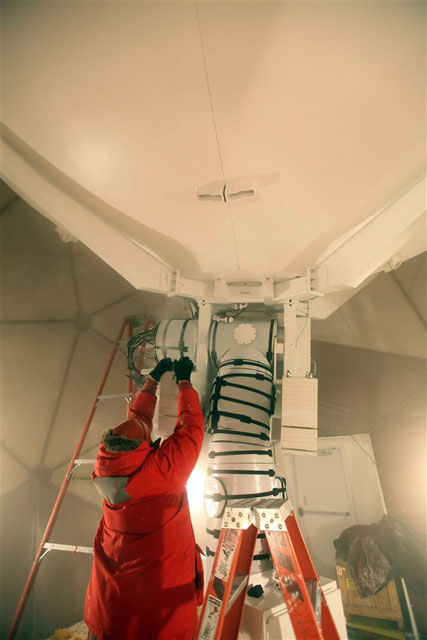
Photo Credit: Sven Lidstrom
Satellite engineer Jeremy Schultz replaces parts on a communications dish.
In late August, we were faced with yet another technical challenge. A wave-guide, used for transferring microwaves to the satellite dish, on our TDRS With all science data relying on TDRS for transfer and no spare parts to be found on station, we were facing severe impacts on operations for the last months of winter. But challenges are there to be overcome. Our station machinist, Derek Aboltins, spent a weekend fabricating the needed parts. Satellite engineer Jeremy Schultz then replaced the damaged components, and we were back to normal operations again within a week. With science continuously happening and creating lots of data to be transferred, this was a very important achievement. August was cold, about minus 3 degrees Celsius/minus 5.4 degrees Fahrenheit colder than average, and we broke two metrological records, both lowest daily temperature ever recorded. On Aug. 5, the temperature reached minus 75.1C/minus 103.2F and on Aug. 14 it reached minus 74.7C/minus 102.5F. At the end of August, we also experienced our second full moon for the month, a so-called blue moon. Most importantly, though, we have started to see light on the horizon, indicating the sun is gradually making its way closer to summer. It is probably about time, since it seems we have forgotten what the sun actually looks like. During the repairs on the TDRS dish, the domed shelter protecting the antenna was lit up. Apparently, the dome, located less than a mile from station, could, in the toasty mind of a winter-over at least, resemble the sun. During the repairs, a very excited voice announced on the all-call channel on the radio that the sun now was visible, weeks before it should be. This resulted in the entire station going outside staring at the satellite dome through the drifting snow and mist, until someone mentioned that the sun very much resembled the TDRS dome. Hopefully, in a couple of weeks, we will know what the real sun looks like. July is toughest month to winter-over at South PolePosted August 17, 2012
July is probably the most difficult month for winter-overs at the South Pole Station Toast is the not-so-medical term for the physical and psychological state you enter at some point during your winter. It is still dark and cold. Sunrise is still two months away. So you are starting to feel worn out, more tired and more than ready to leave. You are dreaming about when you can go somewhere warm and relaxing, where the sun always shines, and where you can take a three-minute shower without feeling guilty. 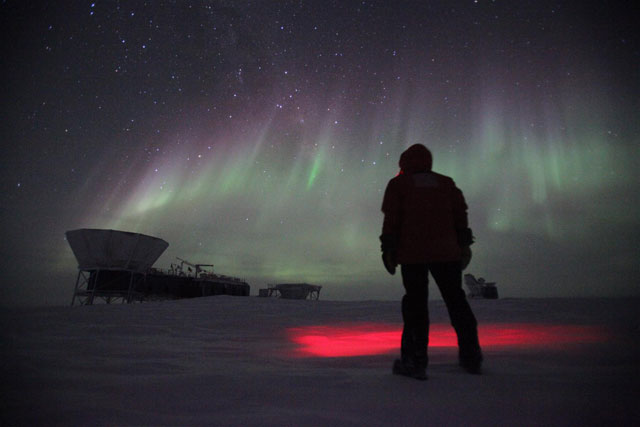
Photo Credit: Sven Lidstrom
A Polie enjoys the aurora show in the Dark Sector at the South Pole Station.
The cure for winter-over toastiness is fun and entertainment. Last month, we tried our best to cure ourselves. It started out with the Vehicle Maintenance Facility crew hosting the Fourth of July party (on July 7). The party included everything you could ask for, except maybe the marching band: A barbecued full pig, burgers, cake and, of course, horseshoe and corn hole games. The Fourth of July fireworks came a couple of days later when AR1520, a big solar storm, hit us. The effects of solar storms can be seen on Earth as auroras, and South Pole in winter is a prime location for aurora watching. Even though AR1520 coincided with the coldest days so far this winter — we officially hit minus 76 Celsius/minus 104.8 Fahrenheit — it didn’t stop us from venturing outside to enjoy the skies going berserk above us. There were also several people proving that Polies are tougher than the rest — or crazier, some would say — since they decided that camping outside is the way to truly enjoy South Pole at below minus 100F. Another big entertainment event in July was South Pole Open Mic Night, when we enjoyed live music, wild stories and other fun things. A big surprise for all of us who are not talented enough to perform was that we all got backstage passes so we could go party with the “stars.” This was a first for me, and I had very high expectations, since you hear a lot about what goes on backstage. And I wasn’t disappointed, although a bit surprised: Rock stars these days party on “fresh” milk — well, Ultra High Temperature (UHT) processed milk is considered fresh after months of the powdered type of milk we are used to — and freshly baked chocolate brownies. It was not what I expected, but definitely what I wanted. The last weekend in July brought the monthly Farmer’s Market in the Food Growth Chamber, followed by Superhero Bingo Night. During July, no weather records were either tied or broken. The average temperature for the month was minus 60C, which is a little colder than normal. Science continues to happen, and this month it happened with minimal technical problems, which allowed Derek Aboltins, our science machinist, time to work on the geographic marker that will be unveiled on Jan. 1, 2013. The monthly emergency response drill took place in the station subfloor, which is a very shallow and tight space below our normal floor. For some reason, both victims and responders turned out being the biggest and heaviest on station, which added to the complexity of the response. A few technical challenges hit the station experiments in JunePosted July 20, 2012
The main event at South Pole Station It will still be months before we will see it again, but at least it’s a turning point, and we all now have a bright, sunny future ahead of us. A committee was formed to plan the event, and they came up with so many great ideas that it turned into a two-day celebration, and we still had to postpone some activities for later. 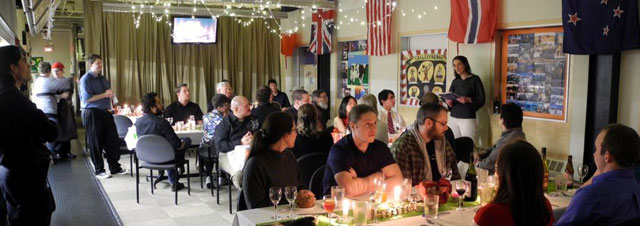
Photo Credit: Sven Lidstrom
Katie Hess, at right standing, gives a speech at the South Pole Midwinter celebration.
The celebration started with a brunch in the station’s hydroponic greenhouse, where its produce was turned into different delicacies. To allow for the food to settle, the afternoon was spent at our very own drive-in movie theater — aka, the gym, which had been turned into a state-of-the-art movie theatre for the occasion. As tradition dictates, we watched “The Shining.” Then the main event followed: Midwinter dinner. This proved to be another culinary extravaganza by our kitchen staff. Five plated courses, served by real waiters and waitresses, added to the experience. After dinner, with the night still young — we still have another couple of months of it — there was an 80s dance party to get rid of those extra pounds. Or, if you were too full to even move, there were late-night movies in the gym. A nice thing with Midwinter is all the greetings we get — from the White House to Japanese ministers, from previous winter-overs to all the other stations on the continent. The latter are extra fun because they normally include photos of the station and its surroundings, as well as the winter-over crew, although some were a bit disturbing to see, since they were standing outside in T-shirts among penguins in sunlight. Their winter-over experience must be a very different one than ours. [See related article — Waiting for the sun: Antarctic research stations observe winter solstice.] Science continues apace, but in June, it required more intervention than normal to make it happen because some of our telescopes had some challenges. The South Pole Telescope The South Pole Upgrades for DASI (SPUD) Weather-wise, June was 1.1 degrees Fahrenheit warmer than normal, and we broke or tied four weather records. The coldest temperature recorded was on June 13 at minus 101.4F. May was a 'super' month at South Pole StationPosted June 15, 2012
Last month was pretty super at the South Pole Station Early May brought a super moon, which is when all forces in the solar system come together to help Polies see what they are actually doing when working outdoors during the 24-hour darkness of winter. (It’s also the informal term used to describe when a new or full moon makes its closest orbital pass by the Earth, appearing huge in the sky.) 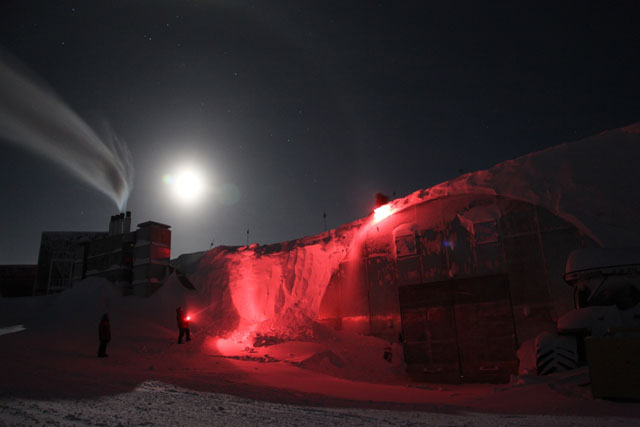
Photo Credit: Sven Lidstrom
South Pole workers use the light of the moon to work during the winter darkness.
After weeks of walking and working in the dark, or perhaps guided by the faint red light of a headlamp, we could all of a sudden see what we were doing and where we were going. We took advantage of this extra moonlight and completed as much of our scheduled outside work as possible. It is amazing how small things like actually seeing what you are doing can make your day. Weather-wise, May was an average month, with no meteorological records tied or broken. Science continues to happen at South Pole. IceCube Otherwise, the big recreational event has been the start of the South Pole 8-Ball Pool Tournament. Nearly half the station participates in a very comprehensive schedule, which will keep us playing pool until sunrise, making our already busy recreational schedule even busier. In order to get all participants in the right mood, a bar has been built and installed in the station’s game room. Another big event, using the creativity of the winter-overs, was the Pole Marker competition. The geographic South Pole marker, marking the actual South Pole during 2013, is designed by South Pole winter-overs, who then vote on the final design. [See previous article — A good point: South Pole geographic marker changes with the times.] Once the winning design has been selected and approved, it will be made by the station machinist, Derek Aboltins. The rest of the world will see the new Pole marker for the first time on Jan. 1, 2013, when it will be uncovered during the moving of the Pole. All Polies are members of one of the station’s emergency response teams, covering every possible type of emergency we could encounter. Every week, since we arrived at station, we have been training and fine-tuning our skills to be ready in case of a disaster. All our training came to use during the mass casualty incident (MCI) drill we had at the end of the month. The purpose of an MCI is to have the different teams interact, while coping with an emergency that is so serious that we are stretching the limits of our resources to the maximum. The drill scenario was an electrical fire in the power plant. The first responders found thick smoke and called on the fire team, which entered, put out the fire, and searched the building. They found four victims, who were handed over to the trauma team, which performed triage and then, with the help of the logistics team, evacuated the patients to the medical clinic for further treatment. The personal highlight of this month was a harvest at the greenhouse, which continues to spoil us. This time it gave us the most amazingly tasty strawberries — pretty super indeed for a winter at the South Pole. Signs of winter appear above the South PolePosted May 18, 2012
April was a month of transition at the South Pole Station For many it was a transition from one employer to another, with the turnover of the U.S. Antarctic Program It was also a transition from cold to colder with the sun below the horizon. We reached minus 100 degrees Fahrenheit on April 7, which is the earliest date ever recorded. Normally minus 100F is not reached until May. [See previous article — Cold front: South Pole hits minus 100F mark earliest ever in the winter.] This enabled the bold and brave to join the very prestigious 300 Club. For a lifelong membership, you need to expose your body to a 300F temperature difference by stewing in a sauna for as long as possible and then walking to the geographic South Pole while wearing minimal clothing. The early membership drive for the 300 Club occurred while there was still a faint streak of orange twilight far in the horizon, and a full moon in the sky. Not surprisingly, April was nearly 4F colder than normal. With the colder temperatures, NOAA Also during April, we started seeing auroras to everyone’s delight. Anyone on station eager to see them can turn their hand radios to the “aurora channel” to get the “aurora alerts” so they know when it is worthwhile to go outside to view these spectacular displays. The station’s aurora cameras are now turned on to observe this phenomenon in detail. In April, the IceCube The dining hall window cover competition proved once again that the South Pole community is a group of very creative people with multiple talents and skills. Every winter we must carefully cover the station’s windows so no light disturbs the very light-sensitive experiments under way. In addition, the walls of the galley have been covered with the flags that flew at the ceremonial South Pole during the summer centennial celebrations for Roald Amundsen and Robert Scott. Easter was celebrated with a delicious traditional dinner prepared by our senior meteorologist Dale Herschlag, since our kitchen staff had the weekend off. We also celebrated the birthday of Yuri Gagarin, the first man in space, with the annual Yuri’s Night party. The 100th anniversary of the Titanic disaster was commemorated with an afternoon and evening filled with Titanic documentaries and movies. We also gathered for a night of Pub Trivia, as well for another Farmer’s Market for everyone to socialize and enjoy the greenhouse produce. Start of winter season brings change in fortunePosted March 16, 2012
South Pole Station Left behind for the winter are 50 brave souls from all over the United States and seven other countries. With the wide variety of skills and strengths among us, this will hopefully be a great experience for all of us. According to station tradition, we celebrated the first evening of winter by gathering in the gym after dinner to watch the sci-fi move The Thing — both the old and new versions. This might have changed a couple of people’s expectations of our coming winter, but now we know how to deal with alien monsters. However, we have yet to locate flamethrowers, as they are not in MAPCON, the U.S. Antarctic Program’s Since Feb. 15, we have been busy getting the station and ourselves ready for winter. We have another few weeks to finish up all outside work before the sun sets and leaves us all in the dark for the next six months. Fuel lines have been recovered, and summer camp (a small tent city used to house personnel in warmer months) has been closed down. We have put flag lines to all exterior buildings, and all loose equipment has been located, and either flagged or moved to keep it from disappearing during winter storms. The coldest temperature of the month was reached on Feb. 29 at minus 52 degrees Celsius, and we broke the previous daily peak wind speed records on Feb. 8 and Feb. 20 with 27 knots and 33 knots, respectively. We have also been able to recover from a very hectic summer season, and on Feb. 25 we celebrated Mardi Gras in true New Orleans spirit. But our happy mode was eclipsed when we found out about the fire at the Brazilian research station Comandante Ferraz, which claimed two lives and injured a third person. In honor of the injured and dead persons, we flew a Brazilian flag at the South Pole during the last week of February. In a small ceremony, it was taken down and folded according to protocol by winter site manager Katie Hess, science lead Heather Moe and station physician Dale Molé. The flag will later be presented to the Brazilian Antarctic program. Science is, as always, happening at the South Pole. Both Small Polarimeter Upgrade for DASI (SPUD) and the South Pole 10-meter The most important people on station for morale and our well-being are no doubt our kitchen staff. They have performed over and above all our expectations. It is hard to believe we are actually at the end of the world. The other night they cooked us yet another delicious dinner, this time on a Chinese theme. They even had some homemade fortune cookies. However, the fortunes were a bit darkly humored. My first fortune cookie said, “You have a long, dark and cold winter ahead of you.” A bit dissatisfied with that fortune, I decided to take another one, hoping for something a bit more encouraging. But my next fortune cookie said, “You should have gotten on that last plane.” Pole wraps up centennial year and prepares for winter hibernationPosted February 17, 2012
The South Pole continued to be the hottest tourism ticket in Antarctica as the new year got under way. Visitors used all manner of locomotion to get to the bottom of the world for the 100-year anniversary since the first men arrived at the South Pole. They used skis, trucks, and even a fat-tire bicycle. About 70 visitors were at the South Pole Station One venerable tradition — though not stretching back a century — is the placement of a new geographic marker at 90 degrees south. The ice sheet moves about 30 feet a year, so it is relocated every Jan. 1. The winter crew the previous year is responsible for designing and creating the marker. In recent years, the brass markers have become increasingly ornate, virtual works of art. This year’s was no different. Designed and built by machinist Steele Diggles, the 2012 marker is three-dimensional, honoring both Amundsen and Scott. The names of the 49 winter-overs from 2011 are inscribed along the base of the pole that supports the marker. A more recent tradition, also on Jan. 1, was the second annual South Pole Marathon, with four runners finishing all 26 miles at an altitude of more than 9,300 feet. The winning time was four hours and 27 minutes. But don’t think it was all fun and games at the South Pole in January. Some major science got done. The South Pole Telescope Station operations moved into preparing the upcoming winter season as the month drew to a close. The last flight of the summer left Feb. 15, leaving 50 people isolated at the bottom of the world for the next eight months. Expeditions continue to roll in to celebrate centennial at PolePosted January 13, 2012
December started out in a frenzy and never slowed down at the South Pole Station Expedition skiers and fly-in visitors began arriving en masse in early December, with many hunkering down at the visitor’s campground awaiting the 100-year anniversary of when the first people reached the South Pole, a group of Norwegians led by polar explorer Roald Amundsen. The occasion included a multiday visit by Norwegian Prime Minister Jens Stoltenberg 
Photo Credit: Peter Rejcek
The ice bust of Roald Amundsen sits on an ice pedestal at the ceremonial South Pole.
Events surrounding the big day included setting up a media shack near the ceremonial pole to conduct two days of live broadcasts back to Norway; creating an Amundsen ice bust, which the prime minister unveiled on the big day; and planning the ceremony marking Amundsen’s arrival at the South Pole on Dec. 14, 1911. [See related article — South Pole anniversary: Norwegian prime minister visits bottom of the world to honor Amundsen.] After the ceremony, Stoltenberg hosted a reception and dinner at the station. A mixer for visitors and science personnel was also included in the day’s events at the last minute, and it turned out to be a big hit with our visitors. Community members and visitors alike participated in some or all of the events, and it was without a doubt a joyous and historical time to be at the Pole — a far different place than when Amundsen found it a century ago using dogsleds. The prime minister gifted a Norwegian flag to the South Pole Station, with Bill Coughran, South Pole Area Director, committing that the station would fly the flag every year on Dec. 14 in honor of Amundsen’s achievement. After the centennial celebrations, expeditions continued to make their way to South Pole, keeping station personnel busy, in addition to keeping excitement high through the Christmas holidays. All of the South Pole Christmas traditions took place. The station kitchen staff pulled off another exceptional holiday meal for nearly 250 people without a hitch. Christmas carolers sent their holidays songs across VHF radio, while the intrepid braved a blizzardy day to participate in the annual Race Around the World. Then a truly strange thing happened on Christmas Day. It got hot — well, warm for the South Pole, with a new record high of about 10 degrees Fahrenheit. [See related article — Heat wave: South Pole hits record high temperature on Christmas Day.] Most Polies will say they’ve never seen temperatures at the Pole above 0 degrees , making it a welcome holiday surprise. On Dec. 27, the second South Pole Operations Traverse arrived with fuel and cargo, which surely means the 2011-12 field season will begin winding down soon. But not before we welcome in a new year with more visitors, many of whom will hope to be here on Jan. 17, to mark the arrival of Briton Robert F. Scott and his men to the South Pole a century ago. Pole readies itself for Amundsen anniversaryPosted December 9, 2011
The summer season of 2011-2012 will be one to remember, with the 100-year anniversary of the arrival of Roald Amundsen and Robert Falcon Scott coming in the next few weeks. The South Pole Station A carpentry team from McMurdo Station The National Science Foundation Other preparations for the festive summer include new signage around the campus for visitors, groomed pedestrian corridors and the setup of a small camping area for those visitors requiring a night’s stay. Overland expeditions are currently racing across the continent from all corners, hoping to set new records, blazing their own trails or following in the footsteps of the great men who first found their way to South Pole. Outside of the centennial preparations, life at South Pole has been busy after a delayed start to the summer research season due to weather. One of the big projects for science this season will be several major upgrades for the South Pole Telescope (SPT) For the latest experiment, workers will need to install reflective shielding on the telescope. Without improving the shielding, which blocks interference from near the horizon, it would be difficult for the telescope to measure the gravitational wave signature from inflation. 
Photo Credit: Kiell Kosberg/Antarctic Photo Library
Polies use a kitchen strainer to observe the partial solar eclipse on Nov 25.
Despite the busy schedule, the station took pause for a couple of social events. Veteran’s Day saw a small group of about 30 convene at the Pole for a short, windy flag ceremony hosted by veteran Ron Carpenter on a brilliant, blue day. Thanksgiving started with a partial solar eclipse the evening before the festivities, with the science support folks hosting a safe viewing from the galley for many in the community, while others took to the outdoors to view this rare phenomenon. As the sun dimmed, it almost felt as if sunset was around the corner, but there are still months and months to go. After the eclipse, mad preparations continued for what was another successful Thanksgiving dinner for the entire station. In the short term, we look forward to the arrival of the South Pole Operation Traverse team any day now after their long trip from McMurdo. The tractor train hauls fuel and supplies about 1,000 miles between the two research stations. We are also preparing to welcome a party of high-ranking U.S. government officials here to survey the current state of the U.S. Antarctic Program, including the South Pole Station, with an eye for making long-term recommendations. The last visit by such a panel in the 1990s led to the construction of the new South Pole Station, which was dedicated in January 2008. Shortly after the Blue Ribbon Panel departs, we will welcome Norwegian Prime Minister Jens Stoltenberg Getting to the South Pole proves challenging in OctoberPosted November 11, 2011
Getting to the South Pole Station A pair of Basler BT-67 aircraft landed at the U.S. Antarctic Program's 
Photo Credit: Peter Rejcek
A Basler aircraft brought in the first summer crew to South Pole on Oct. 17.
One Basler had actually been scheduled to arrive at the station on Oct. 17, but with the first members of the incoming summer crew. However, that didn't happen until a week later on Oct. 24, again due to weather. It took another five days before the next Polies arrived at the South Pole, this time aboard an LC-130 aircraft, flown by the New York Air National Guard By the end of the month, the station population had climbed to 99, with some of the winter-over crew beginning their homeward journeys north. It was a record-breaking winter for some of the winter-over statistics kept by Antarctic historian Bill Spindler, who maintains the nongovernmental South Pole Station website Two people on station during the 2011 winter now hold the record for most winters at the South Pole with eight — Johan Booth and Steffen Richter. Close behind is Robert Schwarz, who is the only person with seven winters. A different sort of milestone will be marked this summer as the station commemorates the 100th anniversary of the famous Race to the South Pole between Norwegian Roald Amundsen and Briton Robert Falcon Scott. South Pole personnel rally together to support airdropPosted September 23, 2011
We began August with the first phase of twilight, heralding the beginning of the end of this winter season. By mid-August, there was a glow coming from the horizon. At times, it was difficult to see because of the moon’s brilliant glow, but the light noticeably increased daily. There were even a few days of faint twilight when the auroras made their final appearance for the winter. Enthusiasm in the station grew with the promise of light and the first meetings about preparations for the coming summer field season. On Sept. 5, we were given the all-clear by South Pole Station Although the solar glow was difficult to discern at that point, it was still quite refreshing to realize that soon the gentle light from the sun will head our way. The sun will finally break the horizon on Sept. 21. We are eager for the actual arrival of the sun to the skies, but also wish that the brilliant twilight would last longer. 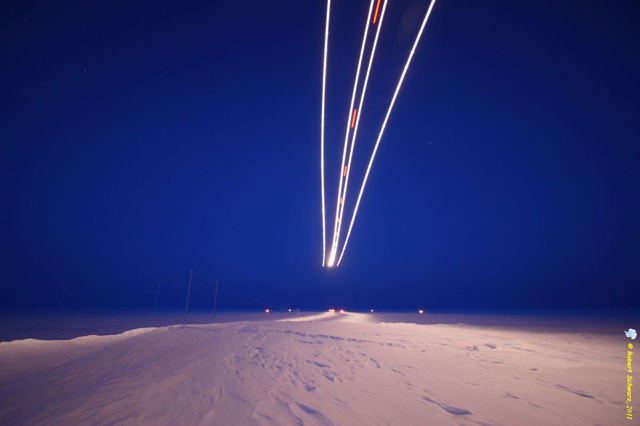
Photo Credit: Robert Schwarz
The lights from the Air Force C-17 leave streaks in the night sky over the South Pole.
At the end of August, we took part in an airdrop involving a U.S. Air Force Globemaster III C-17. This was an exhilarating event that helped wake us all out of our winter “toast” brain and rise to the challenge to quickly make all the ground preparations that were necessary for the airdrop. The whole station came together to make our portion of the airdrop a success so that we could receive essential medical supplies from New Zealand via the U.S. Air Force. The timing was perfect, as there were already planes on the continent to support the late winter operations for McMurdo Station We were also fortunate that there had been very few storms to create sastrugi, or rough snow sculpted by the wind, which would have increased the drop zone preparation time by the equipment operator. The winter weather also cooperated, with temperatures around minus 60 degrees Fahrenheit and 10-knot winds. In addition to the medicine, we also received mail and oranges. Aside from the excitement of the airdrop, the 49 winter-over Polies continue to be busy preparing the station for the summer, from writing end-of-season reports to shifting science support activities as the light changes to settling on our winter-over group photo location. All of the science projects continued to operate successfully in August, with routine troubleshooting and repair of hardware and software. Space weather projects have had a good observing season, with very clear skies this winter. In the dark sector, the astrophysics projects continued to run well while observing the cosmic microwave background or searching for elusive high-energy neutrinos. Air sampling and atmospheric monitoring instruments, surface-based and balloon-launched, continued to gather data in support of global climate studies at NOAA’s Atmospheric Research Observatory (ARO) Despite the physical and mental exhaustion that comes with a South Pole winter, we still spend time together outside of work. We have enjoyed a pool tournament, movie nights, Bingo, and weekly meals provided by various community members. We expect the first Basler aircraft to arrive in mid-October, leaving only one month until the conclusion of this winter season. South Pole slowly shifts out of winter darknessPosted August 19, 2011
Although July was the final month of “true” darkness at the South Pole We celebrated the Fourth of July with a barbeque and baseball movies in the galley, and also enjoyed Christmas in July with cookie decorating, a white elephant gift exchange and a Korean feast. 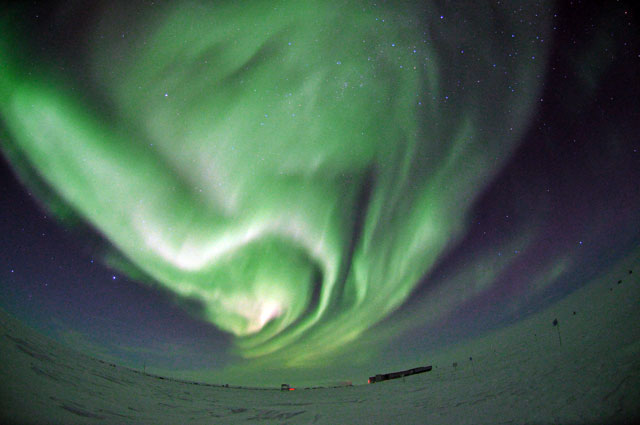
Photo Credit: Christy Schultz
Beautiful auroras still shimmer at the South Pole despite the slow return of the sun to the night sky.
The final weekend of the month stirred the station’s creative juices with the annual 48-Hour Antarctic Winter Film Festival, a filmmaking competition with participation from many of the research stations around the continent. [See previous article: At the movies.] It was a tremendous challenge to awaken our minds from day-to-day routines and create a film that fit the criteria of the festival within the 48-hour timeframe. One of our entries was influenced by our clinic and outstanding medical staff this winter, with a silly twist, of course, entitled, “Perspicacious: Popeye the Surgeon Man.” The second entry, competing in the free category, was “Attack of the Killer DOMS,” filmed in two episodes and influenced by IceCube The South Pole is quite fortunate to have two doctors this winter: Pat McGuire, who is an emergency room physician specializing in family medicine, and Jim Borden, a general surgeon. Jim also happens to be the most seasoned winter-over, at age 74, that the South Pole has seen. I hesitate to use the word old because it doesn’t apply to this fellow, as he said in this interview, “I like doing fun stuff with surgery.” Jim brings a lifetime of experience in this field. He has treated casualties of the Vietnam War and the current conflict in Afghanistan, trained surgeons in Laos, worked with the Peace Corp medical staff in Brazil, worked in Indonesia after the 2004 tsunami, spent time with a Lakota Sioux tribe in South Dakota and had a private practice in Fairbanks, Alaska, for 30 years. Jim was on his way to work at a community hospital in Zambia when he remembered that Raytheon offered medical positions in Antarctica, so he put his Africa plans on hold to spend the winter with us at the bottom of the world. Jim says what he will take away from this overall experience at the South Pole is the beauty of the landscape and skies, and his amazement with how well we are provided for in such a remote setting — and he has plenty of experience in this field! The station and the program have been incredibly fortunate to have both Jim and Pat here this winter. And Jim is not just a star in the medical clinic. He also starred in both of the Pole’s film festival submissions. South Pole midwinter feast is the best in a centuryPosted July 15, 2011
As the sun returns ever so slowly, making its way back to the south, we continue to relish the fantastic celestial shows and stellar jewels glimmering in the South Pole Station Our festivities focused around an amazing meal created by the galley staff that sought to incorporate some of the ingredients used by the first Antarctic winter-overs a century ago. Thankfully, we did not have to rely on dog or seal meat for our main dish choices, as the majority of the ingredients enjoyed both today and 100 years ago were desert offerings like plum pudding and the Napoleon. We began with a cocktail and appetizer hour, and truly enjoyed seeing each other in clothing other than our black and tan Carhartts. The galley was transformed into a beautiful dining room; volunteers had adorned the tables were with flowers from the greenhouse. Others helped to serve each course to their fellow Polies. The evening came to a close with a dance party where we could dance off our wonderful meal. The much-anticipated lunar eclipse on June 16 was met with overcast skies and, subsequently, disappointed spectators. Although we missed the splendor of the eclipse, we are frequently gifted with the auroras, which are often even visible while the moon is up. The magnificent deserts that accompanied the Midwinter meal were prepared by John Burkart. John is currently the galley “grublugger,” which means that he finds and delivers the galley staff’s weekly food orders, and maintains the inventory database. But John is best known for being the baker with the most consecutive summer seasons here at Pole. This past summer was his fourth summer, and he spent one winter as the baker in McMurdo during the winter of 2008. 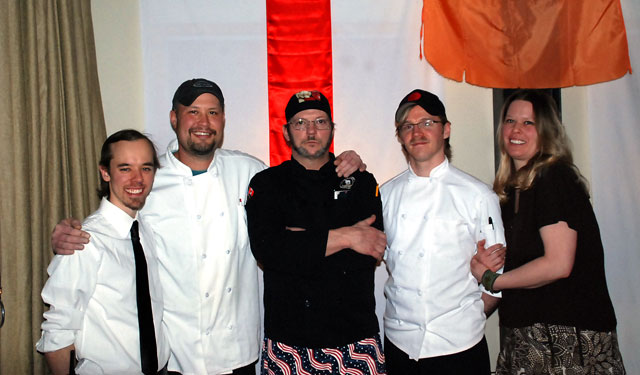
Photo Courtesy: Will Watkins
South Pole galley staff, from left, John Burkart, Bryan Denham, Will Watkins, Jeremy Gepner and Ashley Snyder.
John’s previous experience as a pastry chef in high-volume restaurants in Philadelphia has helped him to bring a level of proficiency and organization to the baking position, which is paramount. He says that obviously the greatest challenge is the altitude, which ranges roughly from 9,000 to 12,000 feet, depending on changes in ambient pressure. Each recipe must be tweaked, and some simply refuse to comply. John says he was initially surprised by the variety of ingredients that he has to work with, and enjoys trying out his tasty creations on the community and being able to receive immediate feedback. John also volunteers many hours each week with community members who are interested in learning how to use the professional appliances in the kitchen, so that we each have the opportunity to share our favorite dishes with one another. What keeps John returning to the South Pole is the freedom to test his creativity in this challenging environment — but mostly he enjoys the sense of community. Night sky offers treats and challenges at the South PolePosted June 24, 2011
May is the month when “Polies” are settled into their work routine, which includes dealing with constant darkness. For many of us wintering here at the South Pole Station Deep into the winter now, recreation becomes an important element for the community. Each night and day off at least one activity is offered to get people out of their routines. Although some enjoy the Pole winter because it grants them time to savor the solitude of our seclusion, having the opportunity to spend time with others in a non-work setting is essential. 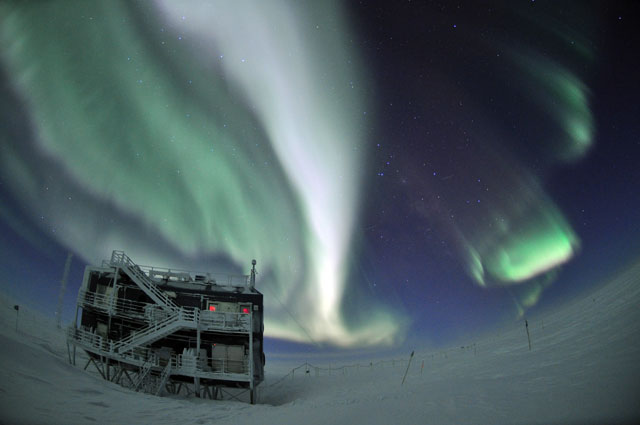
Photo Credit: Christy Schultz
An aurora shimmers over NOAA's Atmospheric Research Observatory at the South Pole.
One highlight was the seventh annual 5K, which here involves doing 18 laps up and down the stairs in the station — in full costume. There were eight participants overall, including two individual competitors and two relay teams of three members each. Weeks Heist won the male and the costume categories; Ashley Snyder won the female category. There were many spectators in the galley, as it served as the headquarters and relay switch-point. Holly Allin and Weeks Heist shared travelogues last month. These offer the audience a sense of adventure and introduce ideas for future travel. Other recreation opportunities include drive-in movie nights, craft night, sports in the gym, bingo, pub trivia, and at least one dance party a month. Susan MacGregor, our growth chamber technician, shared an interesting bit of information concerning an original design for the indoor greenhouse. One of the initial proposals for providing carbon dioxide to the growth chamber was to pipe in CO2 from our berthing units, where the levels rise to over 900 parts per million nightly. Currently, we use cylinders to provide the CO2 for production of our coveted “freshies.” The growth chamber yielded 156 pounds of produce in May. Robert Schwarz, SPUD telescope winter-over, completed his multi-week lecture series on astronomy in May, while Freija Descamps, IceCube We experienced a record in South Pole weather last month, with May 2011 being the coldest May since the Navy began keeping records in 1957. The average temperature was -62.6C/-80.7F. The previous record was from 1989. On May 27, the temperature reached -75.2 C/-103.4F, which allowed for the first meeting of the 300 Club for the winter. Membership requirements involve sitting in a sauna at 200 degrees F and then making a brief visit to the geographic pole while the temperature is below -100 degrees. Our senior meteorologist, Tim Markle, is on his third winter, and he has observed the weather here for three summer seasons as well. Tim spent four years observing weather on Mount Washington in New Hampshire, which until recently was touted as the windiest place on the planet. Tim brings a wealth of experience to Pole’s meteorology department, and even with all of the technology that he has at his disposal, he says that his eyes are still his best tool for observations. During the summer, a typical observation takes just a few moments, but because of the lack of light, the winter observations can take up to 20 minutes, as Tim’s eyes adjust to the darkness. He then uses the minute variances in the moon and star light to determine cloud cover. Tim says that although the South Pole weather is not extraordinary, with the exception of the extreme cold, he finds the greatest challenge here the lack of landmarks and landforms, which are typically important factors in weather observation. The challenges and the wonders of the South Pole night for Tim and the rest of us will continue until September, when the sun returns to the sky for 24 hours of summer. South Pole night sky a highlight of winter isolationPosted May 20, 2011
True darkness has set upon the South Pole Station The world’s southern-most Easter bunny was also busy, as everyone awoke on the holiday to find individualized baskets of treats; it was a wonderful sentiment and a pleasant surprise on Sunday morning. Our head chef worked on his day off and prepared a feast similar to that of his mother's Easter meals of the past, which was appreciated by all. On other days when the kitchen staff is off, community members have stepped in to provide fantastic meals for everyone — a welcome bit of comfort that we can all share with one another. The 24-hour night sky has offered another kind of comfort, as the celestial display is beyond compare! Alert observers will notify the rest of the station by radio when a heavenly aurora appears. Folks don their extreme cold weather gear and head to the closest door. Once outside, it’s common to hear yelling and clapping from the spectators, since there is little else creating sound. The absence of the moon has allowed us to become acquainted with the stars of the southern hemisphere, as most of us hail from the north. Robert Schwarz, winter-over for the Small Polarimeter Upgrade for DASI (SPUD) project It is quite generous for those involved in South Pole science to share their work with those of us who support the research. It contributes to the sense of community. All of the science projects are successfully operating, now that the remaining light-sensitive upper atmospheric and geospace science experiments have been activated. 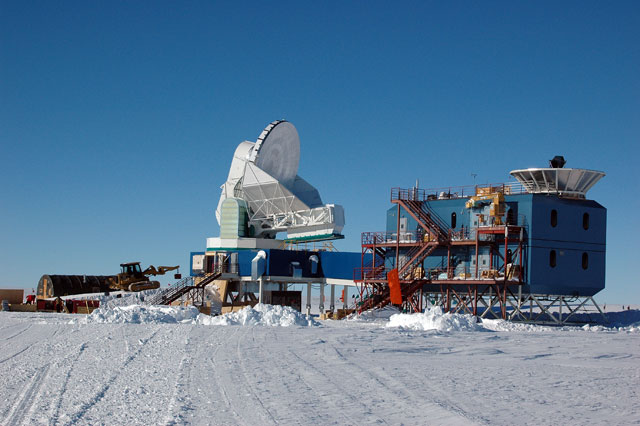
Photo Credit: Peter Rejcek
The South Pole Telescope, left, and Dark Sector Lab during the 2010-11 summer season.
In the dark sector, the astrophysics projects continue to run well, while observing the cosmic microwave background or searching for elusive neutrinos. Once the sun set in late March for six long months, windows of the station and outlying building were covered to prohibit interior station light from contaminating the data of light-sensitive projects. Minimizing outdoor light also provides the best environment for allowing one’s eyes to adjust to the natural ambient light, enhancing safety while walking to remote sites and maximizing the visual beauty of the night skies and Antarctic plateau. And those walks have been getting colder. The average temperature in April was minus 76 degrees Fahrenheit, bottoming out at minus 95.1 on April 18. Some days have been extremely windy, as well, with a record wind gust of 38 miles per hour on April 23, breaking a 41-year record. Sun sets at the South Pole StationPosted April 1, 2011
On Feb. 15, the last New York Air National Guard Due to the extreme snow drifting the station experiences during the winter months, most of the tasks revolve around decreasing the effects that the drifting will have on the next summer field season. Personnel who don’t have particular outdoor assignments are quick to volunteer their time and energy to assist with winterization. As the quickly dropping temperatures prevent the use of most heavy equipment, it is obviously a race to complete these duties with speed before all but one of the machines goes into hibernation. 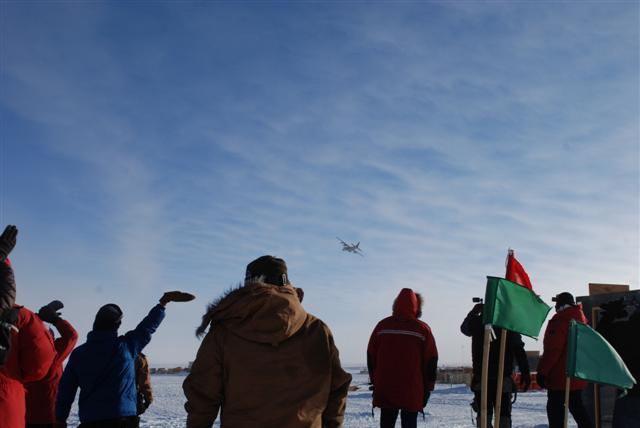
Photo Credit: Renee-Nicole Douceur
Polies wave farewell to the last flight of the 2010-11 summer field season.
All of the mobile buildings are moved to a location far away from the station, known as “the end of the world.” Hundreds of flags are placed to designate paths to outbuildings and to outline the corners of structures. The hose that carries the fuel for the station that is pumped off the LC-130s and into the fuel arch is rolled up and stored for the winter. The winter consumable material, like food, is collected and brought into the cargo facility in hopes of decreasing the trips to the outdoor storage areas in the dark winter months. The official sunset occurred on March 23 at 2:54 p.m., although this does not account for our elevation above sea level or refractive atmospheric conditions. There are three periods of twilight; the final will end on May 12, ushering in darkness and auroras. The windows of the station are covered to prevent light pollution from contaminating research experiments. One of our resident astronomers, Robert Schwarz, is offering an astronomy class to prepare the first time winter-overs for the splendor the heavens will soon produce. On Feb. 25, the first celebration of Commedia dell’Arte Day, a form of theatre that began in Italy in the mid-16th century, happened at the South Pole. Handmade masks were supplied from Antonio Fava in Italy. It was the first time that the play was performed on all seven continents. The kitchen staff traditionally prepares a special meal to commemorate the sunset. The meal included filet mignon, lobster Newburg, duck breast salad, and handmade chocolates. The dining area was transformed into a formal dining room. It provided an opportunity for everyone to dress in something other than cold weather clothing, and relax in the dwindling sunlight. The winter-over crew donated $10,000 — matched dollar by dollar by British Petroleum — to the Red Cross of New Zealand Science roundupWe have several major projects in the field of astrophysics, including BICEP2 and SPUD, which are both telescopes for the tell-tale signals of inflation, a theory that holds the universe expanded exponentially fractions of a second after the Big Bang. [See related article: Inflation at South Pole.] The IceCube Neutrino Observatory There were two new instruments recently installed on the roof of the Martin A. Pomerantz Observatory — the Gattini-UV South Pole Camera and the High Elevation Antarctic Terahertz (HEAT) telescope for Dome A and Ridge A. Both are operating normally and collecting data. The winter meteorological staff collected weather data late in the season to support several flights traveling off the continent for the winter. February was the third warmest one on record, led by 1986 and 1958. South Pole Station goes into winter hibernationPosted March 11, 2011
The last flight of the summer field season at South Pole Station 
Photo Credit: Rickey Gates/Antarctic Photo Library
An aerial of the South Pole Station toward the end of the 2010-11 season.
Station closing activities included the removal of the airfield skiway marker flags, including the approach flags; installation of flagl ines to all regularly visited off-site buildings; removal of the fuel line from the aircraft area to the station storage tanks; clean-up and winterization of the Jamesways (summer living quarters); movement of personnel into winter quarters and much more. Most of the science projects are fully operational as the sun rapidly drops toward the horizon to finally disappear for six months on the southern hemisphere’s autumnal equinox, March 23, when the remaining upper atmospheric physics projects will then be activated. February was the third warmest February on record, with an average temperature of minus 37.2 degrees Celsius. The only years in which the month of February was warmer was 1986 and 1958. Some of the above information came from the South Pole Station science report by winter-over science leader, J. Dana Hrubes, who is back for his sixth winter on the South Pole Telescope NASA makes rare flight over South Pole StationPosted October 29, 2010
An early November storm at the South Pole Station The IceCube Neutrino Observatory Only seven holes remain to be drilled, though the observatory is already functional, collecting data on the rare collisions of neutrinos, elusive subatomic particles, with the atomic nuclei of the water frozen into ice. 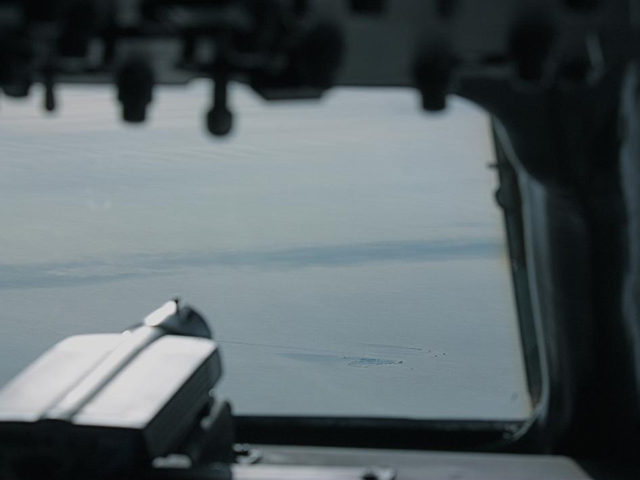
Photo Credit: Sarah DeWitt/NASA
View out of the cockpit of NASA's DC-8 aircraft of the South Pole Station.
The multinational science team, led by Francis Halzen Another big-ticket item at the South Pole this season is work to repair the azimuth on the South Pole Telescope Installation is also underway for the Small Polarimeter Upgrade for Dasi (SPUD) telescope, a next-generation instrument that is attempting to learn more about the process that occurred following the Big Bang In recent years, visitors to the South Pole have also increased exponentially — at least relatively speaking. One of the more unique groups to make the trip to 90 degrees South in November was a scientific expedition from India. The eight-member team reached the South Pole on Nov. 22 after traversing about 1,500 miles in nine days from Maitri, India’s second permanent research station. The expedition traveled on four specialized arctic truck vehicles, which had some problems due to the intense cold temperatures. “We had a little problem with radiators and axles of the vehicles, which we replaced on the way,” said Rasik Ravindran, the expedition leader, in online news reports. Another type of visitor made just a quick pass at the South Pole — literally. A NASA The NASA plane completed 10 flights over 115 hours, covering 40,000 nautical miles – nearly enough to fly around the Earth twice. The National Science Foundation, while not directly involved in IceBridge, handled the mission’s environmental permits for working over Antarctica. In addition, staff at South Pole provided high-rate GPS data to the IceBridge mission, which were critical for the long South Pole mission that originated from Punta Arenas, Chile. First flights arrive at South Pole Station for summerPosted October 29, 2010
The lonely winter is over at the South Pole Station The first flights of the summer season arrived in October. Two Basler BT-67 aircraft landed at the U.S. Antarctic Program’s 
Photo Credit: Ella Derbyshire/Antarctic Photo Library
A Basler aircraft lands at the South Pole in 2009.
The planes were en route from the British Antarctic Survey’s Rothera Station One Basler, a retrofitted Douglas DC3, returned to Pole on Oct. 19 (local time) with new personnel from McMurdo, officially marking the beginning of the summer field season. Temperatures that day ranged between minus 68 and 58 degrees Fahrenheit. The Baslers, along with Borek Air’s de Havilland DHC-6 Twin Otters, provide deep-field support to science parties in Antarctica. In addition, the New York Air National Guard The summer population will shoot up to more than 200 personnel and scientists over the next several months for another typically busy, but short field season. The construction crew for the IceCube Neutrino Observatory The South Pole Telescope Looking for the closest exit as winter comes to an endPosted September 17, 2010
Two of the best days during a South Pole winter might just be when the last summer flight leaves — and, ironically, the day you leave. The former is a distant memory for the 2010 South Pole Station 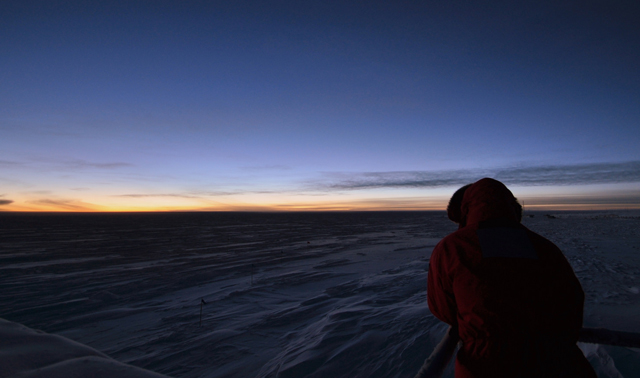
Photo Credit: Nicholas Morgan
A USAP participant enjoys the view of twilight, signaling the return of the summer at the South Pole.
Sept. 6 also marked the beginning of civil twilight, the final stage of sunrise before the sun breaks the horizon. Civil twilight means the window coverings that keep artificial lighting in the main station building from disrupting experiments focused on the night sky can be taken down. The latter of the two best days of winter is now in the forefront of everyone’s mind. Scheduled redeployment dates are being made, and post-Ice travel plans are well under way. Fittingly, one of the best-attended social events of the second half of winter was a play directed by winter-over carpenter David Holmes — Jean-Paul Sartre’s No Exit. The performance starred Holmes as the Valet, UT apprentice Shelby Handlin as Estelle Rigault, physician assistant Emily Wilson as Inez Serrano, and greenhouse technician Joe Romagnano as Joseph Garcin. The play is about three deceased people, each of whom finds the other two individuals unbearable, who must spend the rest of eternity locked in a room together — Sartre’s metaphor for spending eternity in Hell. According to preventative maintenance foreman James Travis III, “It was like Cats performed in Hell, only without the cats.” Holmes chose to direct this particular play at the South Pole because when the last plane of summer leaves in mid-February — and we handful of winter-overs are left on our own with one another for the next eight months — it can seem like we have no exit. However, unlike the three souls in Sartre’s play, we do have an exit, and it is finally near. The sun is almost up and there is a blue tinge is in the sky. Sun-drenched beaches are beckoning! South Pole observatory readies for ozone hole formationPosted August 13, 2010
The National Oceanic and Atmospheric Administration (NOAA) Every year in mid- to late August, the polar vortex, an isolated area of extremely cold air in the stratosphere, develops over the South Pole, causing the formation of stratospheric clouds. These clouds create the ideal base for manmade chlorofluorocarbons (CFCs) in the atmosphere to break down ozone. CFCs are chemical compounds that used to be common in products like aerosol sprays. An international treaty called the Montreal Protocol began limiting human use of CFCs in 1987, and completely phased them out by 1996. However, CFCs have an atmospheric life span of more than 50 years, so there are still millions of CFC particles floating around Earth’s atmosphere that were emitted as long ago as 1960. 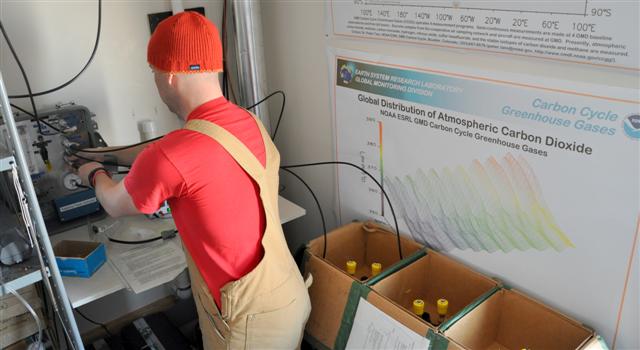
Photo Credit: Nick Morgan/Antarctic Photo Library
NOAA Corps officer Nick Morgan fills flasks with air from the South Pole in the Atmospheric Research Observatory. The facility also monitors ozone depletion as part of its atmospheric observations.
Every August, when the polar vortex forms, the conditions are perfect for CFCs to eat away enough ozone to form a hole in the ozone layer. The polar vortex only exists for a short period of time, and disappears once the temperatures begin warming back up in October. But the residual effect of the CFC damage to the ozone during that time causes the hole to remain until late November or December. During this entire time period, NOAA is busy at work at the Atmospheric Research Observatory One method is to launch ozone balloons. These balloons are specially equipped with devices to measure ozone levels in the stratosphere, and are launched two or three times per week to begin their journey 20 to 30 kilometers straight up. The second method is to use a Dobson spectrophotometer, named after the British meteorologist who developed it. This is a device that can measure ozone levels in vertical columns within the stratosphere from the ground In a healthy atmosphere, levels of ozone sharply increase at the lower altitudes of the stratosphere, and sharply decrease back to normal levels at the middle to upper altitudes. NOAA’s studies have shown that when the polar vortex exists, ozone levels begin their same pattern of increasing at the lower altitudes of the stratosphere, but immediately drop to zero where stratospheric clouds have developed, forming the ozone. That allows the sun’s dangerous, cancer-causing, high-frequency ultraviolet rays — about 97 percent of which are absorbed by the ozone layer when it is in tact — an unobstructed path to the Earth’s surface. According to winter-over NOAA Corps representative Nick Morgan You can follow Morgan's work and adventures at the South Pole at his blog Monitoring Earth's Atmosphere on The Exploratorium's Ice Stories Web site. A French-U.S. team will arrive at McMurdo Station ***
In news from the troposphere, the layer of atmosphere below the stratosphere where people live and breathe, the South Pole experienced some extreme weather. The Fourth of July weekend broke two record low temperatures. On July 3, the minimum temperature of -74.3°C/-101.7°F broke the previous record of -72.8°C/-99.0°F set in 1967. The next day, on July 4, the minimum temperature of -75.0°C/-103.0°F broke the previous record of -71.9°C/-97.4°F set in 1972. July was also an extremely windy month, and between July 15 and 22, several peak and average wind speed records were broken or tied. The windiest day occurred on July 16, with a peak wind speed of 42 knots/48 miles per hour, which broke the previous peak wind speed record of 32 knots/37 mph set in 1978. All that weather made for a cloudy month as well, tying the record for most cloudy days in July at the South Pole at 16, set back in 1990. Midwinter brings deep freeze to South PolePosted July 16, 2010
June 21 marked Midwinter Day for everyone currently on the world’s southernmost continent. Those of us at the South Pole Station Midwinter Day, or the winter solstice for the entire southern hemisphere, is the moment in time when the sun is at its lowest point below the horizon. On June 22, it begins making its journey back toward our skies. Given that the South Pole has only one sunset and one sunrise per year — and that it is generally dark for the entire winter around the rest of Antarctica — Midwinter Day is a unique holiday for this continent. The Midwinter festivities began with a formal dinner. Most Polies donned their nicest attire that they brought with them. The meal was highlighted by the main course of filet of beef seared in duck fat, with black truffles and foie gras, and handmade lobster and pumpkin ravioli. The traditional South Pole party followed the midwinter toast and five-course feast into the wee hours of the morning. Just two weeks later, it was time for yet another celebration — July 4th. Since the South Pole Station is an American base inhabited mostly by U.S. citizens, America’s Independence Day is yet another reason we have to gorge ourselves on good food and throw a party. In following with yet another South Pole tradition, an entire pig had been set aside prior to the end of the summer season for a Fourth of July barbeque. There was plenty of hog to go around, as well as burgers, hot dogs, and other traditional American fare. Real fireworks aren’t allowed, but we played a video of a professional firework display for everyone to “ooh” and “ahh” over. The July 4th weekend also brought about the longest duration of extremely cold weather we have seen this year. The temperature dropped below minus 100 degrees Fahrenheit for a considerable length of time, and set record lows from July 2 to 5. This gave everyone interested plenty of time to complete a third South Pole tradition — joining the 300 Club — if they had not done so back in April when the temperature first dropped below the magical number. Now, as we move past midwinter and perhaps start to see a glimmer of light at the end of the tunnel, people’s thoughts begin to turn to planning vacations and figuring out life post-South Pole. At first it may seem like there is still a long way to go, but as anyone who has wintered here before can attest, these last few months fly by. Before we know it, sunshine will be beating down on us and we will be preparing for the planes to arrive for another summer season. Big science at Pole searches for dark matter, neutrinosPosted June 18, 2010
Compiled from the May 2010 South Pole Station Science Report by Dana Hrubes, station science leader. May is the month at South Pole Station 
Photo Credit: Dana Hrubes
A view of the Milky Way Galaxy, with the South Pole Telescope in the forefront.
Station operations ran smoothly throughout the month. All the emergency response teams conducted training, and a drill was conducted on April 27. Dana Hrubes, a winter-over on the South Pole Telescope South Pole science projects collected valuable data throughout the month, with the big three — South Pole Telescope (SPT), IceCube Neutrino Observatory The SPT is surveying the night sky for galaxy clusters, which will eventually help scientists understand the nature of dark energy, a force believed to be responsible for the accelerated expansion of the universe and about 75 percent of its energy-mass. In May, the telescope continued on a new scan of the cosmic microwave background (CMB). The SPT can locate galaxy clusters by detecting distortions in the CMB, called the Sunyaev-Zel’dovich (SZ) effect. In 2008, the telescope detected its first galaxy clusters using the SZ effect. IceCube is a cubic-kilometer-sized detector buried under the ice at the South Pole. Its focus is the neutrino, a subatomic particle that could offer important clues to major galactic events such as supernovae. This winter, IceCube started collecting data on the 20 new strings of detectors that were installed during the summer, bringing the observatory up to 79 strings and a total of 4,956 digital optical modules. Construction of the last seven strings will finish in 2010-11. BICEP II is a microwave telescope that is also looking at the CMB, the time about 400,000 years after the Big Bang when the universe cooled enough for ordinary matter to form. It hopes to detect a “signature” in the CMB of the time just after the Big Bang when the universe expanded exponentially, to learn more about that inflationary period. As alluded to earlier, May was a stormy month. Five days experienced record peak winds, topping out at 48 miles per hour on May 28, which was also a new record for the month of May. There were only two clear days of the month, which broke the previous record of three days for the least number of clear days in May set in 2006. Consequently, the 13 cloudy days broke the record for the greatest number of cloudy days in May (12) set in 1999. Now serving fresh garden salad at the South PolePosted May 7, 2010
While the brutally cold temperatures and stunning auroras may be the biggest points of public interest during a South Pole winter, it’s often the little things about life at the bottom of the world that are most interesting. Like eating vegetables. 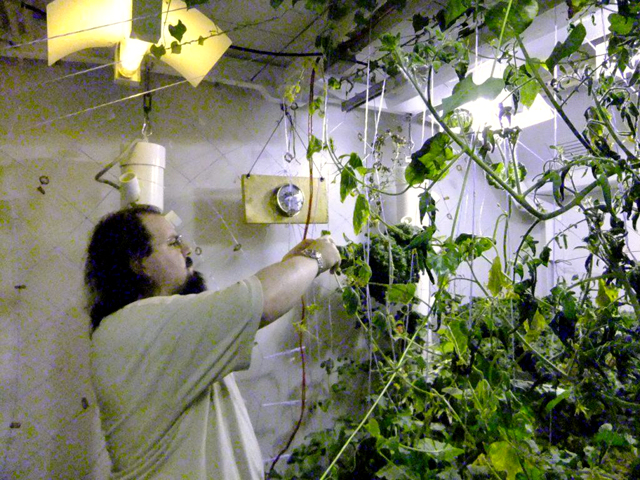
Photo Credit: Jeff King
Greenhouse technician Joe Romagnano works in the growth chamber, an oasis of green and humidity at the South Pole.
After all, garden fresh vegetables do not stay fresh for nine months — the elapsed time between the last plane of the previous summer and the first of the next. We receive no cargo for the duration of the winter. And a two-mile-deep pile of snow and ice on which South Pole Station So, how exactly do the temporary residents at 90 South heed the childhood teachings of their parents to finish their veggies before they have dessert? For one, canned vegetables are simple to store and last virtually forever. Plus, the station’s staff of professional cooks knows enough different ways to prepare green beans that, even after nine months, they manage to continue conjuring up unique veggie dishes. What most people do not know, though, is that we are also able to have fresh vegetables. Yes, it’s true. We had fresh garden salad with our dinner last night. The provider of such luxuries is our Hydroponic Growth Chamber — a greenhouse — that resides in a quiet, albeit most lively, little corner of the Elevated Station. Over the course of the five years that the Growth Chamber has been cranking out freshies, many improvements have been made in the quality and variety of veggies produced. In the beginning, most harvests produced an abundance of lettuce and cucumbers but not much else. According to 2010 winter-over greenhouse technician Joe Romagnano, the Growth Chamber is currently producing between 35 and 40 species of plants, only seven of which are lettuce. The station’s 47 winter-over have already feasted on more than 500 pounds of freshies over the last 12 weeks. Herbs, such as sage and cilantro, are being gown this year, and after cracking the secret to harvesting the first successful spinach crop in South Pole history in 2009, Joe has passed the torch of growing spinach to Winter Site Manager Mel MacMahon through his Adopt-A-Crop program. This fun learning experience allows community members to grow a crop “from seed to feed” under Joe’s tutelage. There are currently seven Polies participating, growing such vegetables as radishes, habanera peppers and eggplant. The Growth Chamber also quietly leads a double life. Antarctica is the driest place on earth, and penguins and seals do not venture anywhere near the South Pole. The Growth Chamber provides Polies with their only escape from the skin-cracking dry air of Antarctica, and their only exposure to non-human life. Entering the greenhouse can cause complete sensory overload for someone who has been at Pole for a few months. In fact, its impact on the human psyche in an environment completely lacking sensory stimuli is so great that human interaction with the Growth Chamber can provide NASA and universities with data they can use in researching advanced life support systems for potential long-duration space flights, such as colonizing the moon or going to Mars. That all sounds pretty glamorous and important; but Polies tend to be a humble group of people. Some hard work goes into keeping the Growth Chamber operational. In the same breathe as talking about the human psyche and space exploration, if you ask Joe Romagnano what he does all day, he says, “I spend about 75% of my time cleaning stuff.” Sun sets at South Pole: Bring on the aurorasPosted April 16, 2010
March 23 was just another day at South Pole Station But there was one difference. It was the last time we would see the sun for six months. Quite a mind-boggling phenomenon, if you really stop to think about it. Unless you have spent a winter at the geographic North Pole — or six months living in a cave — you have to be one of about 1,300 people in the history of humankind who have spent a winter at the bottom of the planet to enjoy this unique experience. The new faces and old hands, alike, anxiously await the last lingering rays of sunlight from below the horizon to give way to the deafening black sky, lit up by seemingly millions of stars and, of course, those ever sought-after Aurora Australis. On the surface, the station may seem much smaller during the winter. The outer buildings are shut down. All the windows on the elevated station are boarded up to prevent artificial light from escaping and interfering with science experiments that require darkness and only natural, ambient light. Despite these physical aspects of a closed-off, isolated building in the middle of nowhere, the six months of dark provide one opportunity so large that it renders the smallness irrelevant — the privilege of gaining a perspective of the world that only a few have ever, and will ever, get to see. 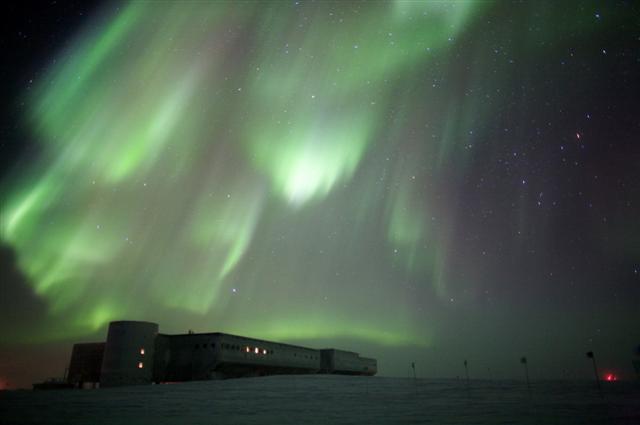
Photo Credit: Patrick Cullis/Antarctic Photo Library
An aurora above South Pole Station in June 2009.
Anyone who knows a winter-over Polie has heard the stories and descriptions, seen the pictures, and probably wonders themselves, “What is it like to stand outside at minus 90 degree Fahrenheit — with not a cloud in the sky or a breathe of wind — and look up to see stars seemingly at the end of the universe and the green, purple and red auroras dancing the tango for hours across the sky?” Imagine going to a laser light show at the planetarium. The room has a chill in the air. The lights start, choreographed to music by Pink Floyd, which really creates that “wow” feeling of being in another world. Now imagine the universe, rather than a person, created the lights, then turn the thermostat down by 150 degrees, exchange Pink Floyd for dead silence, and multiply the “wow” feeling by a thousand. This is one of the major reasons Polies become Polies in the first place. And now it is that time of year. Our eyes are on the sky, and our camera batteries are charged and ready. Someone cue up Dark Side of the Moon! South Pole crew braces for winter seasonPosted March 12, 2010
When the summer crew turns the reins over to the winter-overs, the South Pole Station This year the last flight of the summer field season, which departed South Pole at 3 a.m. on Valentine’s Day, left behind 47 people to keep the station running until October. “Skier 301 is on deck. The crossing beacon is on. Please avoid the skiway. This is the final outbound passenger flight of the season,” sounded over the all-call and radios. A handful of winter-overs, who had either stayed up or set their alarm, stumbled out to the flight deck to wave goodbye to summer, as the remaining summer-only folks boarded the plane for McMurdo Station The ski-equipped LC-130 offloaded the last bit of fuel for winter, lifted off, made a hard bank to the right, and circled around for a low-level flyover, providing excellent photo opportunities. A few people still on the ground waved. Some clicked their cameras. Some toasted the beginning of winter. And, as always, a few jokingly cried out for the plane to come back and get them, as we watched it disappear over the horizon. The walk back into the station was quiet and serene. The sound of propellers loudly buzzing on the flight deck — gone. The sound of night-shift equipment operators driving bulldozers — gone. The sound of large groups of people socializing in lounges — gone. Walking into the station: the clank of the external freezer door closing and the lumbering of bunny boots on the floor echoed through the hallway. Otherwise, silence. Those who have done this before smiled with the knowledge of what’s to come, and those who have not are excited for their new adventure. 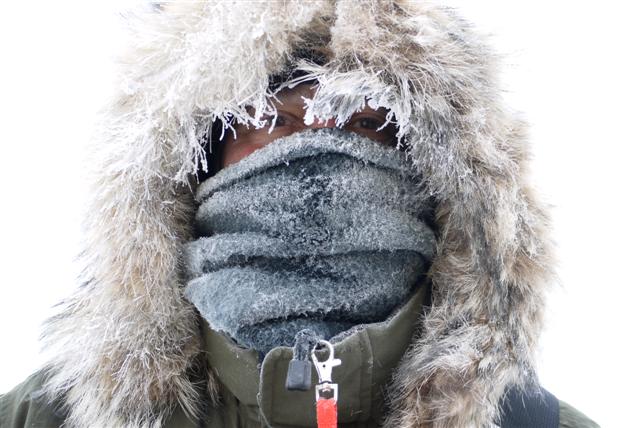
Photo Credit: Michelle Handlin/Antarctic Photo Library
James Reaves, South Pole safety engineer, is one of 47 Polie winter-overs.
The next day was Sunday, so many of us ushered in the new season by upholding a long-time South Pole tradition — setting up a movie theater in the gym and watching The Thing the day after the last flight until summer begins again in October. Monday, it was back to work. We have many tasks to accomplish to winterize the station. To name a few: The fuel lines must be taken down and stored, outlying buildings from the main station must be prepared for electricity and water to be shut off, and the flags that line the skiway and approach markers must be taken down to prevent snow drifting. With 21 of the 47 people having previously wintered at Pole before — for a cumulative 839 months of time in Antarctica — this was nothing new, and winterization went without a hitch. Now we look forward to the sun giving way to the winter darkness. Much to celebrate at South Pole as new decade beginsPosted February 5, 2010
South Pole Station Polies transformed the gym — normally used for volleyball, basketball, swing dance class and morning stretching — into a New Year’s Eve party hall, with decorations, lighting, and a large stage. The evening’s entertainment showcased the talent and many hours of practice put in by the station’s resident bands and musicians. Blue grass, folk, country, rock-and-roll, and even a punk-rock cover band, performed. During intermission, a Wearable Art fashion show featured some of the spare treasures lying around the South Pole. Polies scavenged for spare pieces of rope, coaxial cables and cardboard boxes to make wearable creations to show off down the model runway. The crowd favorite was a giant cardboard box made into a wearable forklift, with operating lifting tongs, worn by a seasoned machine operator. The beginning of 2010 wasn’t the only thing to celebrate at the South Pole this month. The IceCube Neutrino Observatory finished drilling all 20 holes into the ice sheet this season on Jan. 20 — a full 10 days earlier than originally projected. The experiment requires a team to drill 2.5 kilometers into the ice to deploy a string of digital optical modules to learn more about neutrinos, subatomic particles from space. [See recent story: Big science.] The drill crew stuck around to empty their water lines, winterize the construction camp and prepare for next summer, which will be their final drilling season. The dome deconstruction also finished this month. The construction crew dismantled all of the panels, and the station carpenters have been busy crating the pieces for the cargo department to ship them off the continent. The annual South Pole Film Festival (SPIFF) debuted on Jan. 23 to a packed room. The film festival premieres short films written, filmed and produced at the South Pole. A rap music video parody of “I’m on a Boat” titled “I’m at the Pole” garnered many cheers and a repeat showing. Several season-long competitions ended last month, including Scrabble and cribbage tournaments. Winners received prizes for local restaurants in Christchurch, New Zealand. Some of the coldest competition occurred during the annual South Pole Snow Sculpture contest. Large blocks of snow were placed near the ceremonial pole for use. Teams and individuals willing to bear the cold sculpted the ice into frozen art. Winners included a pair of polar bears (ironic, since they only live in the Arctic) and a sculpture in tribute to the station’s beloved, if belligerent, Frosty Boy ice cream machine. Yes, that’s right: The South Pole said goodbye to a very dear and beloved friend this month. Frosty Boy, a soft-serve ice-cream machine, finally swirled cold, sugary goodness into its last cone. Though Frosty Boy has been replaced in the dinning room by a scoopable ice-cream freezer unit, it will never be replaced in our hearts. May you rest in peace, Frosty Boy. Cargo, fuel arrive at South Pole in unusual waysPosted January 8, 2010
The South Pole Traverse, a caravan of tractors and heavy machinery charged with crossing about 1,000 miles of Antarctic ice, arrived at South Pole Station The is an important part of station operations, as fuel generally arrives on LC-130 flights operated by the New York Air National Guard The traverse’s arrival has kept the South Pole fuel crew busy offloading the massive delivery. The fuel bladders actually pose an interesting dilemma for the crew: The LC-130s have pumps to push fuel off the plane into the station’s holding tanks. But the traverse bladders need to have the fuel withdrawn, similar to sucking on the straw of a juice box. In order to accommodate both of these needs at the South Pole, the “fuelies” use a unique valve, created especially for the South Pole Station’s fuel pumping needs, which can regulate both positive pressure and create negative pressure. Besides being stocked with fuel, the South Pole was also stocked with dried food goods in December via an Air Force C-17 airdrop. The plane made two circles along the drop zone, dropping 13 bundles weighing approximately 14,000 pounds. The bundles consisted of dry food such as flour, dried milk, rice and cereal. Airdrops during the summer are done primarily as practice in the event of a need for a winter resupply mission. Many of the station crewmembers hiked out to watch the bundles drop and take pictures of the C-17 flying overhead from a designated safety zone. The South Pole growth chamber, the station’s specially designed hydroponic garden, is gearing up for the winter-over season. The technicians have been busy cleaning in preparation for the upcoming winter growing season. South Pole community members chipped in and volunteered their time during a Christmas Eve planting party by planting various fruit and vegetable seeds in the hydroponic growth chamber. These seeds will grow into plants that will be harvested by the winter staff long into the winter when planes have stopped delivering fresh produce to the station. The growth chamber team isn’t the only crew working hard to finish projects before the season ends. The carpentry crew has been racing to finish installing the last of the elevated station’s paneled siding. The final areas they’re attacking are the underbelly of the station, its support pilings and several smaller stand-alone buildings. The deconstruction of the old station dome is moving at a rapid pace. A crew of six started dismantling the dome’s 164-foot circumference base while waiting for special tools to begin taking apart the top of the dome. The crew ended December working from the top of the structure, removing triangular plates in expanding rings. [See related story: Deconstruction of the Dome.] The IceCube Neutrino Detector Observatory project The South Pole celebrated Christmas with a special meal in the dining hall and the annual Race Around the World. This year the 2.25-mile course consisted of loops around both the old dome and the Elevated South Pole Station. Curtis Moore won men’s first place with a time of 17:17:43 and Emily Thiem won women’s first place with a time of 20:48:33. Highlights included a welder who ran backwards, several festive costumes, and tractors decorated as medieval floats. South Pole population swells as main season beginsPosted November 6, 2009
Summer has officially begun at South Pole Station 
Photo Credit: Dr. Ella Derbyshire/Antarctic Photo Library
The Basler aircraft arrives at South Pole on Oct. 19, bringing the first summer people to the station.
But the faces weren’t entirely new to the winter-overs; many of the first passengers are seasoned veterans of South Pole life. Members of the community gathered in the dining hall to welcome old friends back and also to eat the first fresh fruit seen on station since last February. Incoming executive chef James Brown scheduled each of the first few planes to bring a few boxes of delicious fresh food, including bananas, kiwi fruit, plums, apples, fresh eggs and more. The summer arrivals have brought fresh energy to the station, and work began immediately on making it ready for the larger Hercules LC-130 aircraft operated by the New York Air National Guard Before then, the “First Flight Festival” was held Saturday night, Oct. 24, with more than three hours of live music. The festival is a way for the winter-overs to display their talents and welcome the new arrivals. Summer and winter personnel mingled in the gym during the show, and a penguin piñata provided comic relief for everyone. The winter staff eagerly snatched up the candy inside the piñata. “I haven’t had a Starburst in over a year,” exclaimed one gleeful employee. The musical slate for the evening was just as exciting as the candy, with the women’s a cappella group “The Polecats” opening the show, followed by a variety of single-song performances by solo, duet, or trio groups, and closing with our two main winter rock bands: “The Rookies” and “April the Leukemic Cat.” Highlights of the show included an ensemble piece with piano, vocals, drums, guitar, bass, violin and trumpet, and a solo guitar performance by engineer Nathan Greenland of his song about life at the South Pole during the winter. Now that the festival is over, the winter-overs are ready to step aside and allow the new summer talent to take over. Scientists Erik Shirokoff and Ross Williamson report that this winter was a record season for the South Pole Telescope (SPT) Sunlight returns to the bottom of the worldPosted October 9, 2009
The sun is finally above the horizon at the South Pole for the first time in six months. We celebrated the occasion with the traditional “sunrise dinner” on the weekend of the equinox. The South Pole Station The sunrise festivities were a welcome diversion from the flurry of activity of the previous week. A late winter storm set wind records of as high as 48 miles per hour for Sept. 10-12. The sustained winds left behind record snowdrifts. More than six feet of snow covered the massive double doors in front of the garage arch after the storm, and the storm almost completely buried the Logistics Arch. The Martin A. Pomerantz Observatory (MAPO), home of many astrophysical projects, also suffered severe drifting and heavy equipment had to excavate part of the site. According to meteorologist Kristina Shiroma, sunrise is a particularly stormy season for Pole. This is due to a greater heat imbalance between the interior and the coasts, as the sea ice starts melting each spring. Cold air from the interior mixes with warmer air on the coasts, creating larger storms, which the jet stream pushes toward the interior. Other than cleaning up after the storm, members of the South Pole winter-over crew are busy preparing for the coming summer season. The first planes since Feb. 16 are due to arrive on Oct. 12 — Kenn Borek’s Basler BT-67 and Twin Otter airplanes, flying all the way from Canada to McMurdo with a stop at South Pole — and there is much to do before they arrive. Opening activities include warming up buildings that have been cold during the winter, creating a skiway and fuel pit for the planes, digging out drifted buildings, staging materials for construction crews to use when they arrive, and preparing rooms in the station for new occupants. Since the return of the sun, research associates Jonathon Miller and Robert Fuhrmann have been shutting down their winter aurora and atmospheric experiments, and putting them away for the summer months. They can simply power down some of these winter-only experiments for the summer; others need to be covered for protection or even disassembled and stored. However, the geological experiments that Jonathon and Robert monitor (including seismometer and magnetometer equipment) continue to collect data year-round. [See previous article: MacGyvers of polar science.] Out at the Atmospheric Research Observatory (ARO), NOAA South Pole air is the cleanest in the world, and scientists use the samples as a baseline measurement for air taken from other locations. Once summer arrives, these air samples will head to three main locations: the Commonwealth Scientific and Industrial Research Organization Sun begins its journey to the horizon but temps remain coldPosted September 4, 2009
Winter is rapidly coming to an end here at South Pole Station 
Photo Credit: Patrick Cullis/Antarctic Photo Library
The impending sunrise at South Pole means the spectacular night sky, like in the photo above, has begun to fade.
In one of the longest running projects of the winter, the lighting in the new Logistics Arch (LO) is almost finished, with only a few installations remaining. [See related story: South Pole Storage.] The workhorse behind this enormous project — 150 lights and more than 60,000 feet of wire — has been electrician Monty Myrtle. Monty insists he couldn’t have completed the project without the folks who volunteered to give him a hand throughout the winter. In celebration of the accomplishment, about half of the station population attended a lighting ceremony down in the LO, complete with root beer floats for everyone. With August also comes the return of light from the sun. Erik Shirokoff, grantee with the South Pole Telescope Aug. 1 brings astronomical twilight to the Pole, meaning the sun is greater than minus 18 degrees below the horizon, and the dimmest stars start disappearing. Aug. 21 is the beginning of nautical twilight, with the sun at minus 12 degrees. Sept. 7 marks the beginning of civil twilight, and with the sun at minus 6 degrees, all but the brightest stars will have disappeared. Then, around Sept. 21, we will look to the horizon for our first glimpse of the sun in six months. These first signs of sunlight have caused mixed emotions among the current South Pole winter-over crew. Many have expressed surprise at seeing sunlight again, saying it seems too early for the darkness to be disappearing. Others lament the loss of the beautiful auroras, Iridium flares, and starlight skies that we have all enjoyed this winter. But for most, the light on the horizon is a welcome sight, spurring many to dream of post-Ice travels and reunions with friends and family. 
Photo Credit: Patrick Cullis/Antarctic Photo Library
A Scott tent sits next to the ceremonial pole while an aurora shimmers in the background and the Milky Way shines above.
But so far, the August sun has not brought the South Pole any extra warmth. According to meteorologist Kristina Shiroma, August has been the coldest month of the winter with nine days below minus 90 degrees Fahrenheit, and the coldest temperature of this winter (minus 98.0 degrees) occurred on Aug. 17 and 18. The cold temperatures have hampered a few projects, such as the delivery of materials for LO rack construction or the changing out of waste bins, since such work requires the use of heavy equipment that cannot operate in extremely cold weather. But on days when the weather slips into the acceptable range for heavy equipment, there is always a flurry of activity, and people pitch in to help get the most use out of the equipment before the weather changes again. The warmer days have kept heavy equipment operator Boyd Brown extra busy, sometimes working late into the night or getting up early in the morning in order to take advantage of the warm temperatures. Soon, however, temperatures will rise, along with the work tempo as the summer field season arrives. Polies enjoy fresh veggies in dark of winterPosted May 8, 2009
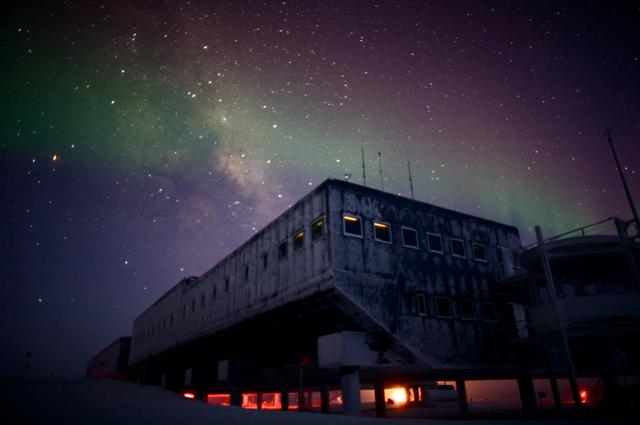
Photo Credit: Patrick Cullis/Antarctic Photo Library
Aurora shimmers in the night sky over South Pole Station.
As the South Pole winter moves toward its fourth month, the crew of 43, the smallest in a decade, has settled into a regular work schedule that provides maintenance for the station, troubleshooting, and scientific observation. The big story at South Pole Station The recent meteor shower peaked April 22, and appeared to come from the constellation Lyra, the harp, which is below our horizon. According to research done by our station doctor, Ella Derbyshire, these shooting stars are made of small dust particles left behind from the passage of Comet Thatcher. They heat up as they enter the atmosphere, and a few of them leave lingering, faintly glowing trails. The Lyrid shower Auroras “When this stream of electrons and protons impacts with our atmosphere, they excite the various gases, releasing excess energy that appears as light moving in shapes across the night sky. “The 11-year solar cycle affects the frequency and brilliance of the aurora we see. The sun is currently close to its solar minimum, producing a slight zephyr of particles. During the next five to six years, the sun’s activity will increase, culminating in large coronal mass ejections, which will light up the night sky with increasingly powerful aurora. Nevertheless, even with the sun at a minimum, the power and beauty of the aurora is still impressive here at the South Pole — a wonderful display.” 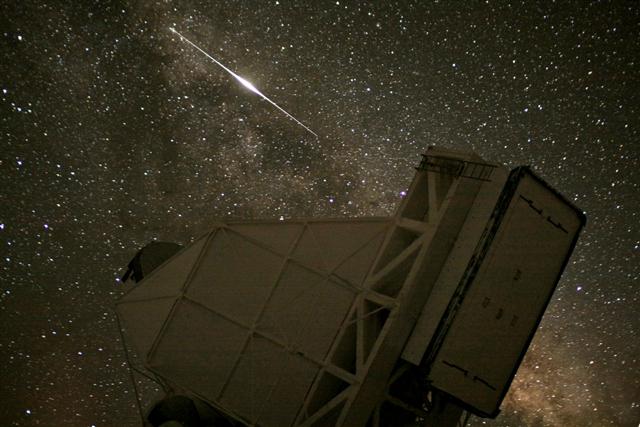
Photo Credit: Keith Vanderlinde/Antarctic Photo Library
An Iridium flare appears above the South Pole 10-meter Telescope.
Iridium flares “During the brief period when one of these panels is aligned so as to reflect sunlight to an observer, the satellite appears much brighter than usual,” he says. “The satellites are normally just barely visible to the naked eye, but can outshine the brightest stars in the sky during one of these 20-second flares.” Shirokoff adds that the satellites are 800 kilometers above the surface of the Earth, and even as it seems dark as night to our eyes from the ground, the airborne equipment can be in direct sunlight when the sun is below our horizon. Indoors, the South Pole Growth Chamber 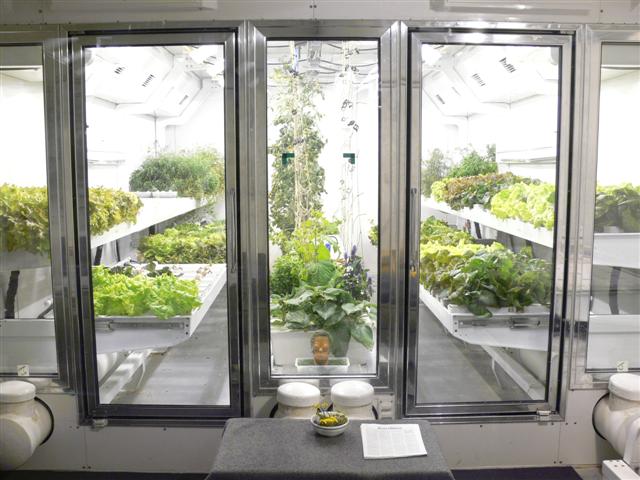
Photo Credit: Lane Patterson/Antarctic Photo Library
The South Pole Growth Chamber uses artificial lighting and hydroponics to grow fresh vegetables.
Joseph Romagnano, who, with a PhD in Crop Physiology from Utah State University (and refers to himself as Greenhouse Joe, South Pole Farmer) oversees the chamber, which is on the cutting edge of hydroponic technology. According to Joe, the chamber is constantly in the experimental stage, and is something we might someday see on space colonies where there is no natural sunlight, earth-like soil, or moderate outdoor temperatures — very much like conditions at Pole. In the first nine weeks of the 2009 winter, the greenhouse produced close to 340 pounds of freshies for the station. That means the crew enjoys newly harvested greens almost every night. The most prolific growers are lettuces, cucumbers, jalapeno peppers, basil and dill, but we have also enjoyed beautiful chard, mizuna, arugula, and even a handful of the first tiny, sweet Alpine strawberries, a first for the growth chamber, which was built during the winter of 2004. Some other crops are still growing and are expected to yield cilantro, bell peppers, the edible flower nasturtium, watermelon, and cantaloupe, among others. Smallest crew winters at South Pole since 1999Posted March 16, 2009
The onset of winter at South Pole 
Photo Credit: Dr. Ella Derbyshire/Antarctic Photo Library
South Pole construction workers William J. Stiner and Todd Adams install siding on the roof of the elevated station.
The last plane for the summer season left the flight on Feb. 16. It was still warm — about minus 39 degrees Fahrenheit — but since then, temperatures have several times reached 50 below, the line at which hydraulics can freeze, making flying impossible for most larger aircraft. A crew of 43 — the smallest group to winter at the South Pole in 10 years — is now family for the next eight months. Winterizing the station requires special tasks in every sector. About 2,000 feet of fuel hose had to be rolled in from the ice, a project that took 12 volunteers two-and-a-half days. Six volunteers spent seven hours removing the flags that that mark the skiway and approach signals over a five- to six-mile area so they don’t blow away during upcoming winds. In food services, triwall boxes of supplies were moved from the outside snow berms to the protection of the old Dome station, so material specialists won’t have to venture too far during dark months when the thermometer can hit minus 100 degrees Fahrenheit. There are ongoing projects slated for the 2009 season. Currently, two carpenters are working to install siding on the roof of the elevated station. Due to the extreme environment, it will take two to three times longer to complete than urban construction. 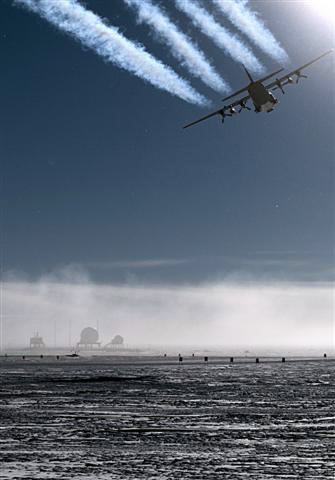
Photo Credit: Eric Shirokoff/Antarctic Photo Library
Last flight of the 2008-09 summer season leaves South Pole.
Strapped in safety harnesses on top of the building about 50 feet from the ground, they work in an exposed space where 20-knot winds surge by unhampered. Yet despite wind chills that drop the temperature to 90 below, the carps are already ahead of schedule. Over this austral winter, the South Pole Telescope On top of all this, each South Pole winter resident has a side job that addresses safety concerns — working the fire, trauma, logistics, or communications teams to keep the people, station, and outlying buildings from any mishap. They participate in regular trainings and drills to remain sharp and ready to handle any situation that could arise. The winter-over crew this year has a few returning Polies, and also many new staff members. Yet what is consistently remarkable in this tiny corner of the world is the extraordinary community spirit. Everyone — from the station doctor to the head of the facilities, engineering, maintenance and construction department — has a day of dish pit duty every six weeks, a nine-hour shift supporting the dining area by making beverages, vacuuming floors, cleaning tables and, of course, washing dishes. On top of this, every resident has house mouse duties to keep the station tidy, and often volunteer for morale activities, whether it is working in the store, baking bagels, creating a lounge area, hosting a film festival, starting a musical band, or teaching a class. Overall, Polies intend to make the intense experience of wintering here the best it can be. We look forward to a season of accomplishments as well as a lot of fun. Traverses arrive at South PoleThe South Pole The South Pole Traverse, an overland tractor train, arrived by a snow route from McMurdo Station after 52 days. The traverse reportedly had a tough slog through an area called the shear zone, a crevassed region. The traverse is a logistics operation that delivers cargo and fuel by sled using large tractors. An altogether different traverse, the Norwegian-U.S. Scientific Traverse During the 2007-08 season, the scientists traveled overland from the Norwegian Troll Station on the coast toward the South Pole, stopping at Plateau Station and the Pole of Inaccessibility along the way. Mechanical problems with the transfer cases on the vehicles stopped the traverse some 350 kilometers short of the South Pole. But the traverse appears to be back on track, with the team expecting to spend about 10 days at the South Pole, reloading the sledges with supplies and equipment for the return journey, according to the expedition Web site. It will make its return journey to Norway's Troll Station across the Recovery subglacial lakes and the Dronning Maud Land ice sheet. The team expects to reach Troll Station in February. Polies remain plenty busy supporting science at the station, with a record population of 279 tipping in on Dec. 13. A construction crew continues to install siding on the new Elevated Station. The IceCube project Despite the long hours, station personnel find time for a little recreation. Activities include everything from yoga to pub trivia. Polies are showing their creative sides with an art show, an ice sculpture contest and fiction-writing competition this month. New faces appear at PolePosted November 14, 2008
Oct. 26 was a clear, sunny Sunday afternoon — a balmy minus 50 degrees Fahrenheit with low wind. About 20 winter-overs stood lined up along side our freshly groomed and flagged skiway, looking horrifically toward the skies to our left. It appeared at about 4 in the afternoon. First, a tiny black dot. Then an unfamiliar moving object. Then there it was, on the ground, throwing contrails off the snow like mud off the back tire of a dirt bike at the starting line. The much anticipated, and simultaneously feared, Basler airplane skied toward us at a brisk pace, came to a stop, and opened its doors. One by one, it unleashed 17 bright-eyed, bushy-tailed, orange-colored people upon the South Pole The skittishness and overwhelming feeling of the winter-overs quickly evaporated, however, by the appearance of bananas and oranges from the pockets of the strange beings from a foreign land. They come in peace, but just how did they know this particular offering would work? We didn’t care. We just snatched up the glorious fresh fruit — the first since the last plane left in February — and lost the ability to focus on anything but stuffing these delicious treats into our salivating mouths. The next day brought another Basler flight and another 17 new faces to scare the daylight out of us whenever we see them walking down the hallway. Another couple hundred people are scheduled to arrive at Pole over the next month, and the ultra-busy and chaotic summer season will be in full swing. And the 60 of us will be blissfully unemployed, sitting on a beach somewhere in the world, sipping beverages with tiny umbrellas in them. The Winter-over Ceremony, one of the great winter traditions at South Pole, occurred a couple days after the first flight arrived. Katie Hess, South Pole Winter Site manager, called each person up individually to receive his or her Antarctic Service Medals Congress provides the medals, a gesture of appreciation to anyone who has completed a U. S. expedition to Antarctica. The ribbon on the medal is symbolic of the changing seasons at the South Pole. The outer bands of black and dark blue take up five-twelfths the width of the ribbon, and symbolize the five months of darkness during winter. The middle bands of gradually lighter blue and white stripes represent the seven months of daylight, as well as the aurora australis that appears during the dark months. Three words are engraved on the back of the medal. According to Public Law 600, passed by the 86th Congress in 1960, “Although the former rigors and dangers of Antarctic exploration have largely been banished by technology, the words on the reverse of this medal are yet a wise injunction to those who go to the Antarctic: Courage, Sacrifice, Devotion.” Sun finally appears at PolePosted September 26, 2008
Spring is the briefest of seasons at the South Pole, but the growing season is yearlong thanks to an indoor hydroponic greenhouse. Polies celebrated the season with the first-ever Farmers Market in the station's South Pole Food Growth Chamber, coordinated by winter-over Greenhouse Technician Teresa Eddington. Participants could choose from an assortment of fresh, hydroponically grown vegetables such as broccoli, cucumbers, kale, lettuce, onions, and assorted greens and herbs. Approximately 15 pounds of produce was harvested by Polies, which individuals used to flavor up their Sunday meals or drinks, such as salads and mint sun tea. The year’s one and only sunrise is the big highlight in September at the South Pole. In the wee hours of the morning on Sept. 22, the sun once again appeared above the horizon, though its light had already been illuminating the sky for some time. A week into September, we finally removed window coverings placed over all station windows during the dark months to protect light-sensitive science equipment; we also stopped using headlamps outdoors weeks prior to the actual equinox on Sept. 23. Because the sun rises over several weeks, those of us lucky enough to see it witnessed quite a show. Some transitions of light that last just minutes or even seconds in places of the world where the sun comes and goes daily, will last for hours or even days at the South Pole, allowing us to see shades of color that most people have never seen in the sky before. September and sunrise also marked the continuation of the wildly popular Pole Stock concert series, with the Mother of Pole Stock show featuring several groups for the two-day weekend at sunrise. Stations residents have rehearsed and performed gigs during off-duty hours all winter long. Along with the return of the sun come high hopes and aspirations for travel plans. The winter-over crew will be departing the continent in less than two months, and the fact that the majority of us are contract employees means plenty of fun in the sun awaits. And we’ve already made plenty of travel plans. Some of the adventures include rock climbing Down Under in Australia; hiking in the Andes mountains of South America; African overland tours; packing up the family and moving to Costa Rica; spending nine months training to be a scuba diving instructor; a motorcycle road trip from coast to coast across the United States; and soaking up some sun in Hawaii. Of course, many of us will roam around for a spell in New Zealand, the main gateway for the U.S. Antarctic Program to Antarctica. As the 2008 winter season nears its end and sunlight returns to our skies, the tired and sometimes burnt-out workers finally can literally and figuratively see that light at the end of the tunnel! |
Home /
Around the Continent /
South Pole Station Archives
"News about the USAP, the Ice, and the People"



For USAP Participants |
For The Public |
For Researchers and EducatorsContact UsU.S. National Science FoundationOffice of Polar Programs Geosciences Directorate 2415 Eisenhower Avenue, Suite W7100 Alexandria, VA 22314 Sign up for the NSF Office of Polar Programs newsletter and events. Feedback Form |


